Renaissance Learning REC-1001 Classroom Response System User Manual AccelTest SW man
Renaissance Learning, Inc Classroom Response System AccelTest SW man
Contents
- 1. Users Manual Part 0
- 2. Users Manual Part 1
- 3. Users Manual Part 2
Users Manual Part 1
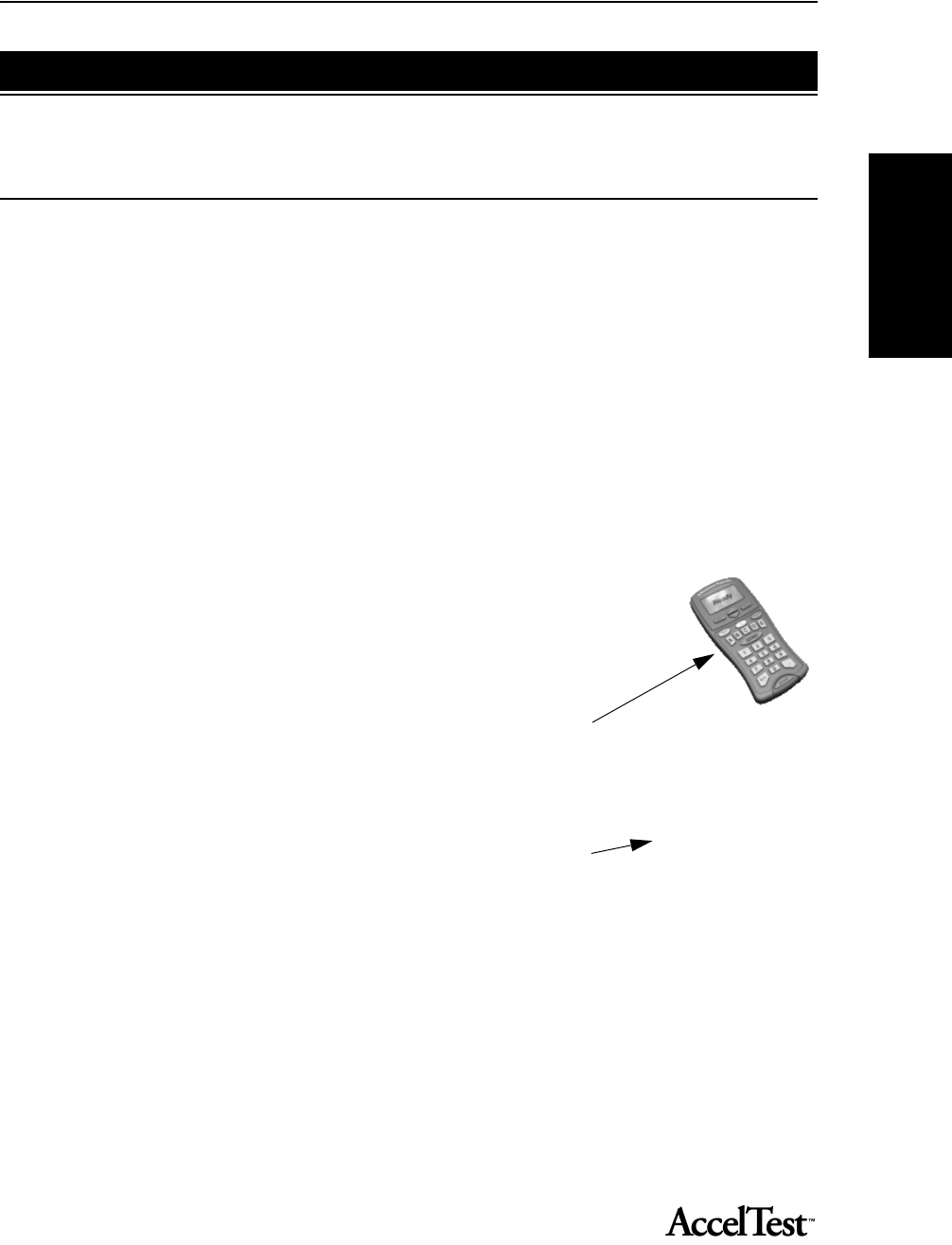
Welcome
1
Welcome
About AccelTest
Thank you for selecting AccelTest, our new test creation, scoring, and gradebook software.
Now you can instantly create your own quizzes, tests, and assignments for any subject, score them
immediately, and have them automatically entered into an electronic gradebook! In addition, you
can easily manage all of your existing assignments, quizzes, and tests.
There are two major optional accessories that you can use to take full advantage of its capabilities.
Renaissance Classroom Response System
Responder - RES-1000
AccelTest is designed to work with the optional Renaissance
Classroom Response System. The wireless, radio frequency (RF)
technology coupled with the Renaissance Classroom Response System
encourages student participation and permits instant teacher access to
see how students are using quizzes, tests and formative assessments.
One part of the system is the student-operated Classroom Responder.
Receiver - REC-1000
The second part is the Receiver, connected to the teacher’s computer.
The Receiver provides an RF link between the Responder and the
teacher’s computer. Student responses at the Responder are instantly
transferred to teacher’s computer - teacher input in the form of notes,
as well as some assessment or assignment content can be transferred
by the RF wireless link to the Responder.
Welcome
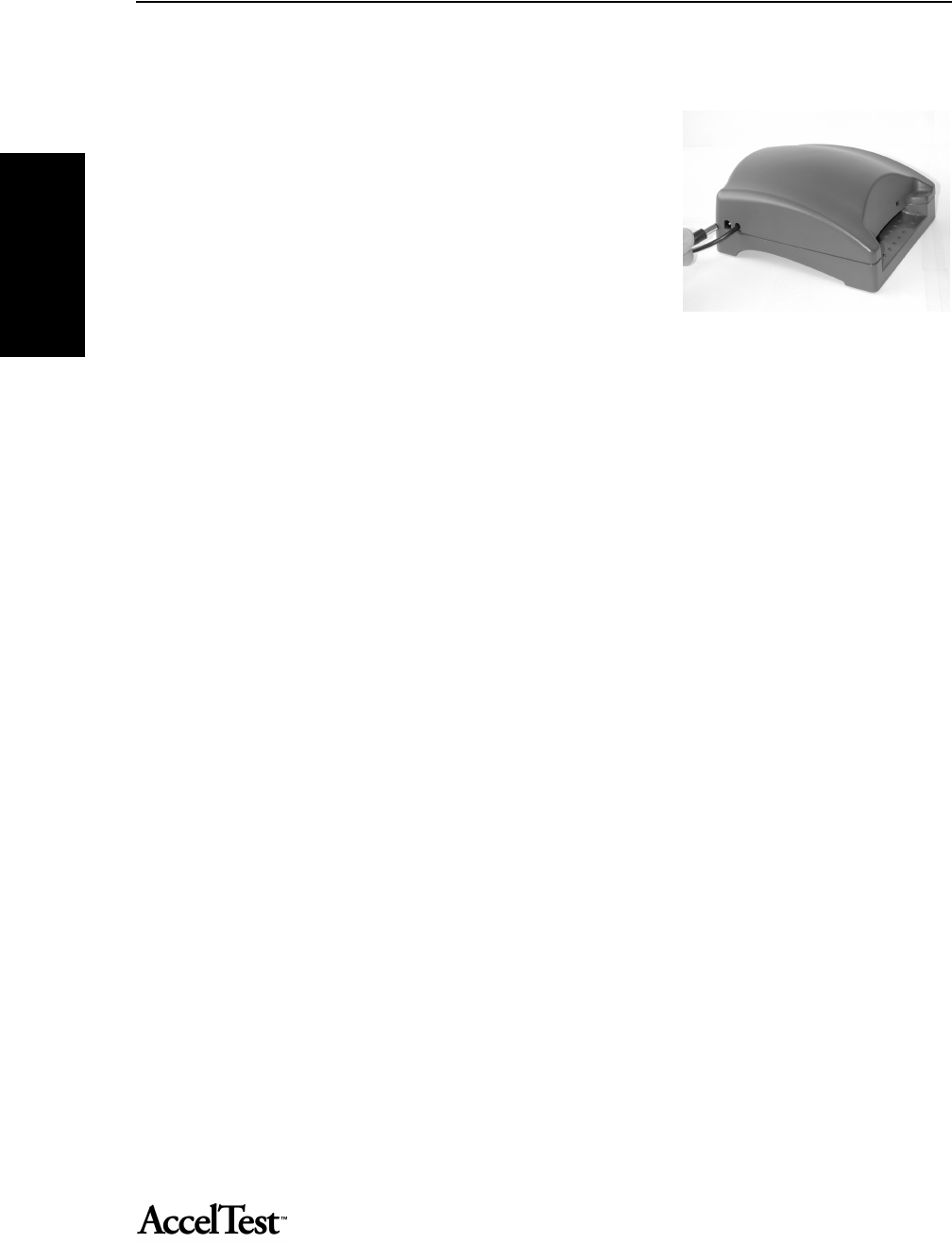
Welcome
2
Welcome
AccelScan
Students fill out a scan card as they complete an assessment, then
use the optional AccelScan to score (scan in) the answers at the
teacher’s computer.
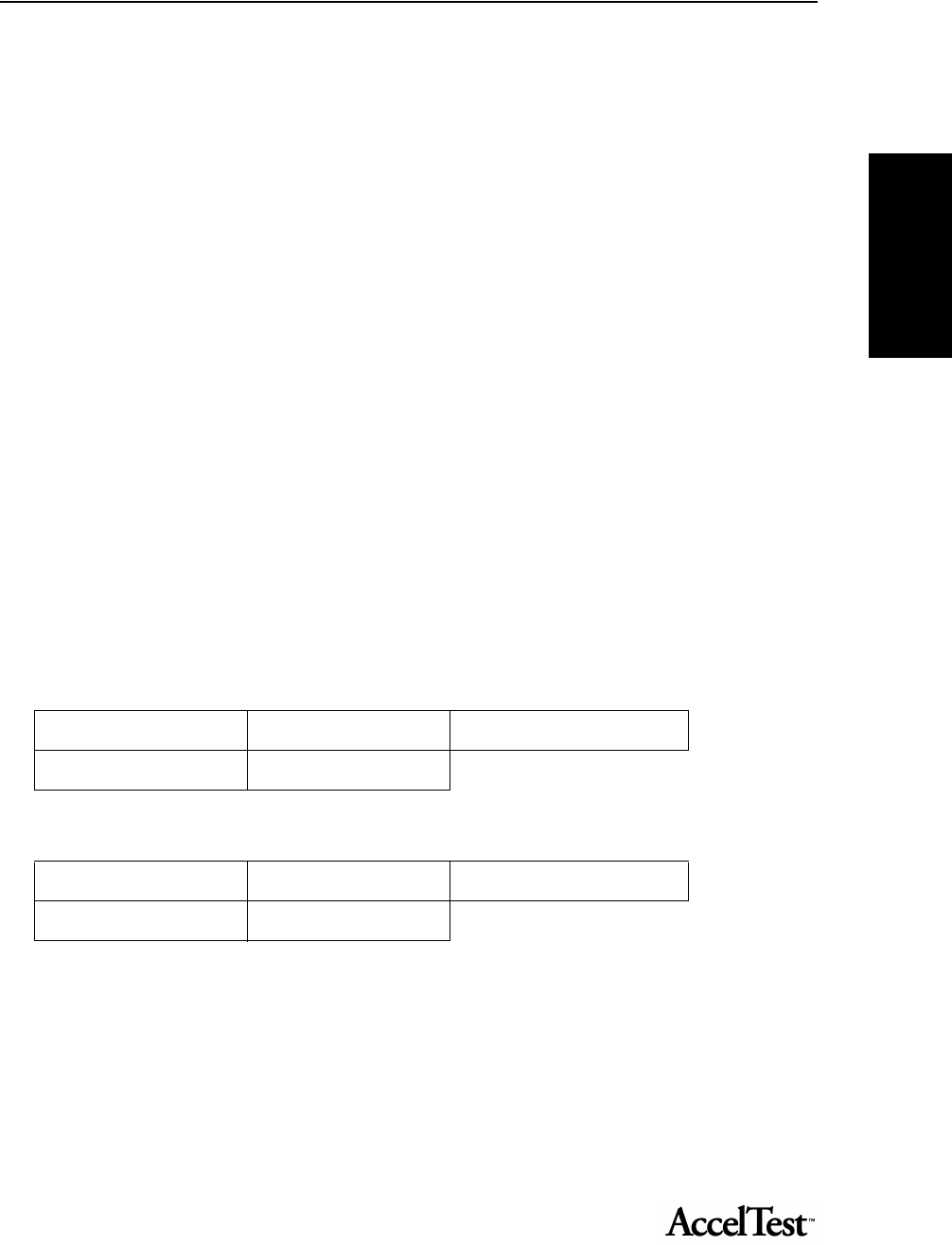
Welcome
3
Welcome
AccelTest helps you, the classroom teacher:
• Quickly create your own customized quizzes, tests, and assignments for any subject.
• Save time! Score the work of an entire class in just minutes!
• Easily manage all of your existing assignments and tests.
• Dramatically reduce the time you spend recording grades by hand.
• Increase your preparation and teaching time.
• Immediately identify student problem areas and intervene through the use of detailed, easy-
to-use reports.
• Become a more efficient, effective teacher.
How does AccelTest Work?
AccelTest is a software product that consists of three main components: Assignment Creation,
Assignment Scoring, and a Gradebook.
Assignment Creation
AccelTest gives you the ability to create your own assignments containing the following types of
assisted response questions:
AccelTest also supports the creation of free response questions.
Only numeric response questions can be scored on the Classroom Response System. There are no
free response questions that can be scored using the scanner.
Multiple Choice Matching Ranking
True/False Yes/No
Essay Blank Short Answer
Numeric Response Modified True/False
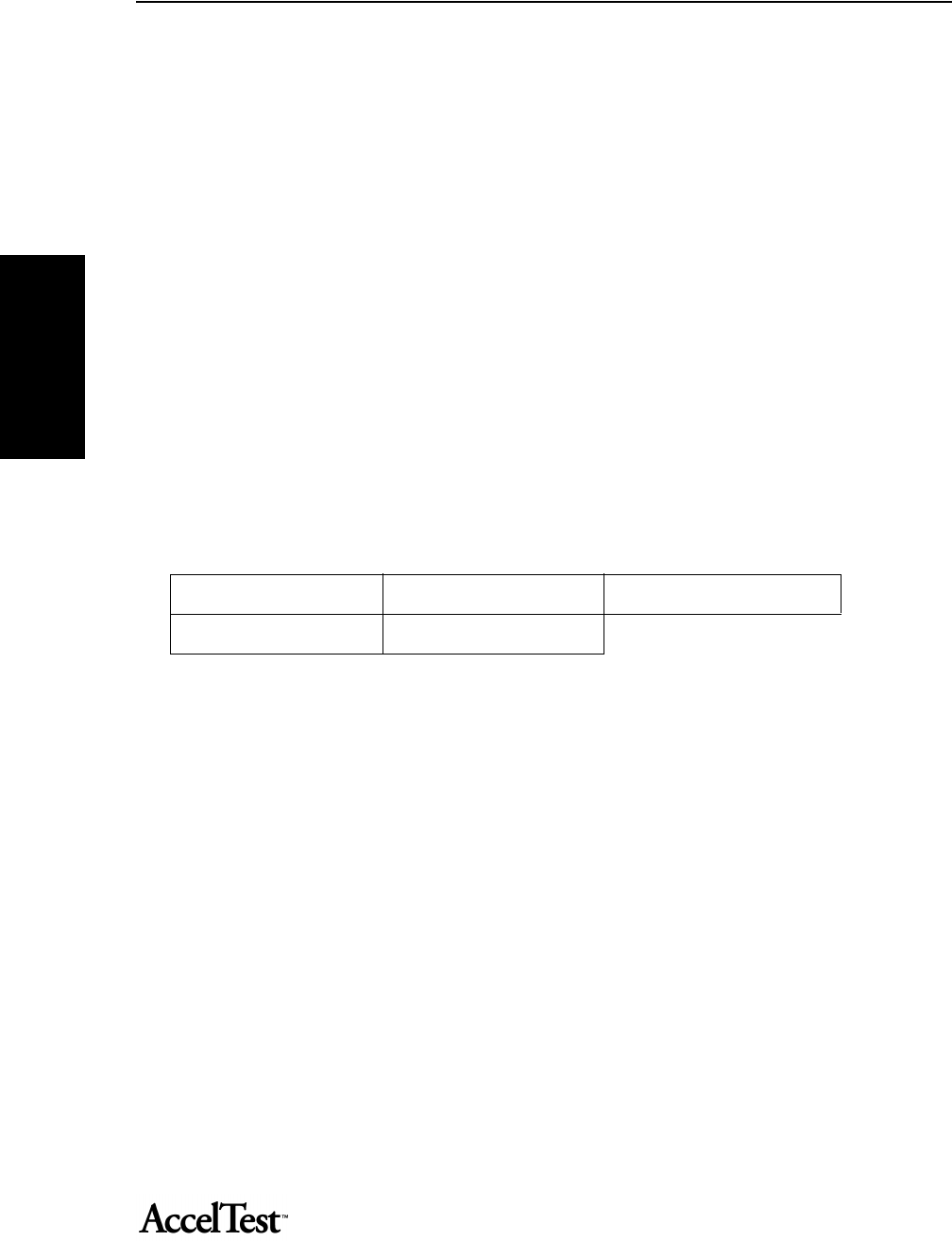
Installing AccelTest
4
Installing
AccelTest
Assignment Scoring
To optimize scoring, you must have either the Classroom Response System or an AccelScan
scanner or ideally, both, on the classroom computer where AccelTest is installed.
The Classroom Response System allows student answers to be instantly recorded as they are enterd
on the Responder.
Assignment scanning in AccelTest allows students to record their answers on an AccelTest scan card
and run it through the AccelScan scanner to score it. This is similar to Renaissance Learning’s
Accelerated Math and Surpass programs.
AccelTest automatically scores the student’s assignments and records the grades in the Gradebook.
AccelTest works with either the AccelScan Model RL-2110 or the AccelScan Model OMR-1100.
Gradebook Functionality
The Gradebook in AccelTest allows you to switch between different sections of students or
different subjects, using the drop-down menus. The Gradebook holds specific information about
each assignment.
When you enter a student name, AccelTest assigns a 3-digit student identification number.
Students can be imported from other Renaissance Learning programs, as well as other gradebooks
that are .csv export capable.
Other features
Teachers define school year dates and term dates to be used for determining grades.
There are Grading Scale Options (Standard A - F, Pass/Fail, O-S-I-U, and 1 - 10 scales) which
include capability for teacher-defined percentages that are used to determine grades, as well as
teacher-defined and weighted categories (Test, Quiz, Homework, and Extra Credit, for example).
The Gradebook displays calculations based upon the number of points earned versus the number
of points possible. However, you can decide whether to display points earned or percentages in the
Gradebook.
There are also numerous reports available in AccelTest. See “Reports” on page 43.
Assignment Title Assignment ID Category
Due Date Points Possible
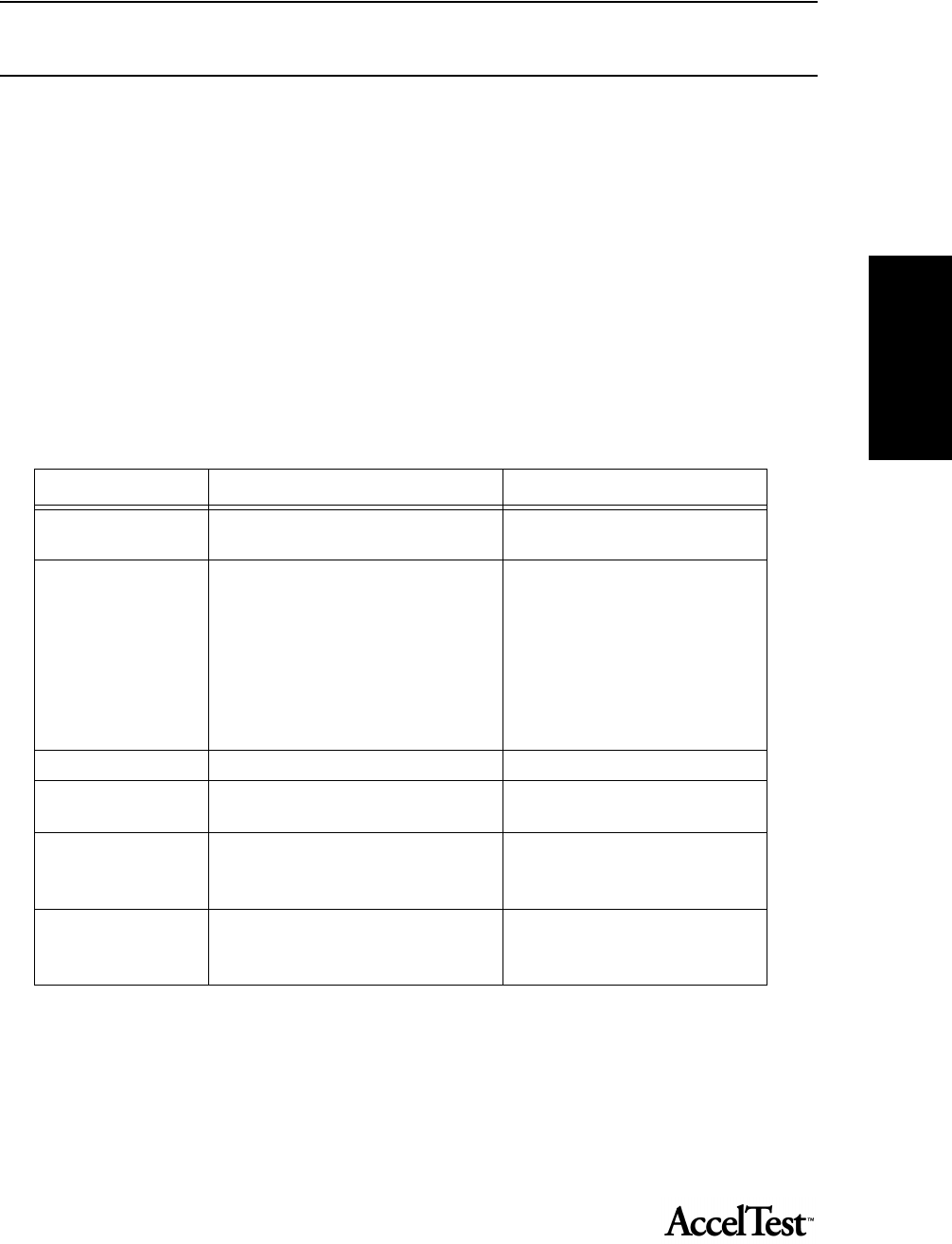
Installing AccelTest
5
Installing
AccelTest
How to use this Manual and Online Help
This manual will help you become familiar with your AccelTest software. You can get help while
using AccelTest by clicking on Help.
AccelTest operates much the same on both Windows and Macintosh computers. When differences
occur, we provide information for both operating systems. Note that in Windows computers,
Wizards are used, and Macintosh computers use Assistants. Both Windows and Macintosh screens
are shown in this manual.
If you have additional questions or need more information about AccelTest or other Renaissance
Learning software, you can email us at answers@renlearn.com.
For technical support, email questions to us at support@renlearn.com.
In this manual, we use different symbols and type styles to identify buttons, menus, and dialog
boxes or screens on your computer screen. We also identify computer keys on your keyboard.
When you need to type information in a field, we use a different font to identify what you need to
type. For example, “Type admin in the ‘Enter your password’ field,” in the AccelTest Password
dialog box.
Item How we identify it in the manual Example
Button Square brackets appear around button
names.
Click the [Assignment Bank] button.
Dialog Boxes Dialog box names appear in bold.
Sections of the dialog box and field
names appear with initial capital letters.
Options within the dialog box are
enclosed in quotation marks.
In the New Section dialog box, type
your section name in the Name field.
In the Import Students Wizard
(Assistant) dialog box, select “Import
from a Renaissance Learning LIS
product.”
Keys Angle brackets appear around key names Press the <Enter> key.
Menus Menu names and menu items appear in
bold type.
From the Gradebook menu, select
New Student.
Screen names Screen names appear in bold type.
Specified areas in the screen appear with
initial capital letters.
In the Gradebook screen, in the
Students column, click on the name
of the student you are selecting.
Shortcuts Menu shortcuts are shown as “Reports
menu > Student Grade.”
From the Student Grade screen,
(Reports menu > Student Grade)
click on Print.

Installing AccelTest
6
Installing
AccelTest
Where to Find the System Requirements
Before you install AccelTest software, make sure your computer meets the following minimum
hardware and software requirements. For the latest system requirements, visit www.renlearn.com/
requirements. If you have questions, email us at answers@renlearn.com.
Installing AccelTest Software
Refer to the AccelTest Installation Guide for instructions on how to install your AccelTest software
and connect optional items such as the Renaissance Classroom Responder System and AccelScan.
Installing AccelTest
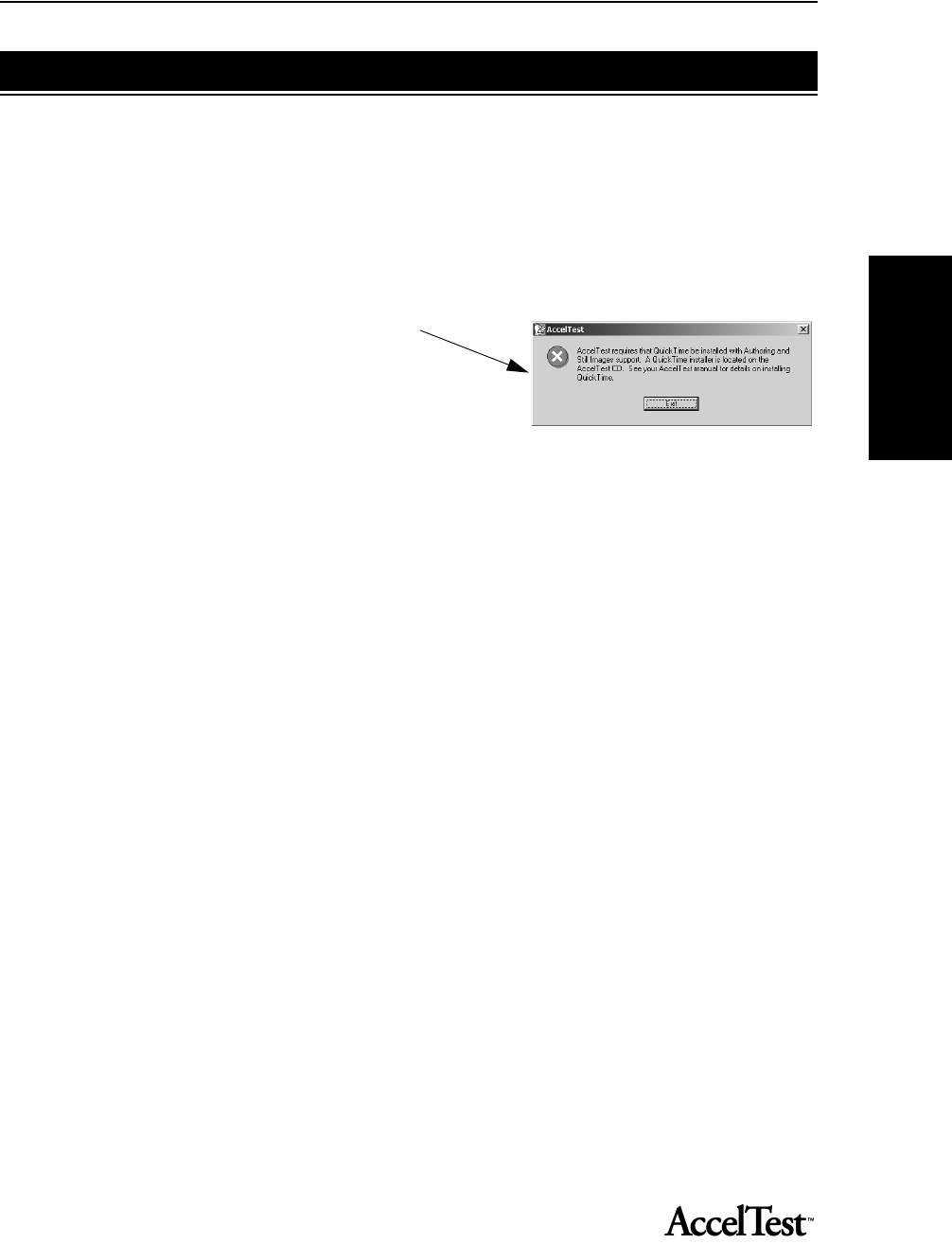
Installing AccelTest
7
Installing
AccelTest
Follow these steps to start AccelTest, if it is not already open.
1. Windows computers: Click the [Start] button and select Programs, AccelTest, and AccelTest.
Macintosh computers: If it is not already open on your desktop, open the AccelTest folder on your hard
drive. Then, double-click the AccelTest icon to start the program.
When the Registration dialog box opens, go directly to step 2 on the next page.
If one of two messages appear, you will need to
either a. upgrade or b. install QuickTime.
If the message states you need to install Authoring
and Still images support, you have a partial
QuickTime installation. See a. Upgrade QuickTime.
If the message states that you need to install QuickTime, see b. Install QuickTime.
a. Upgrade QuickTime
To add the missing components in Windows:
• Click Start and Programs. Select QuickTime.
• Click on the QuickTime updater. Select Custom.
• Go to the QuickTime folder and click on the boxes next to “QuickTime Still Images” and “QuickTime
Authoring.” Click [Update Now].
To add the missing components in Macintosh:
• Navigate to your QuickTime folder. It probably is in your Applications folder.
• Launch the QuickTime updater. Select Custom.
• Go to the QuickTime folder and click on the boxes next to “QuickTime Still Images” and “QuickTime
Authoring.” Click [Update Now].
b. Install QuickTime
To install in Windows and Macintosh:
• Insert the AccelTest CD-ROM in your CD drive.
• Navigate to the Extras folder and open the QUICKTIME folder. Double-click the QUICKTIME file for the
installer. Select default settings and click [Next], and [Agree] at the license agreement. You will not need
to enter anything on the registration screen. Click [Finish] when done.
Starting AccelTest
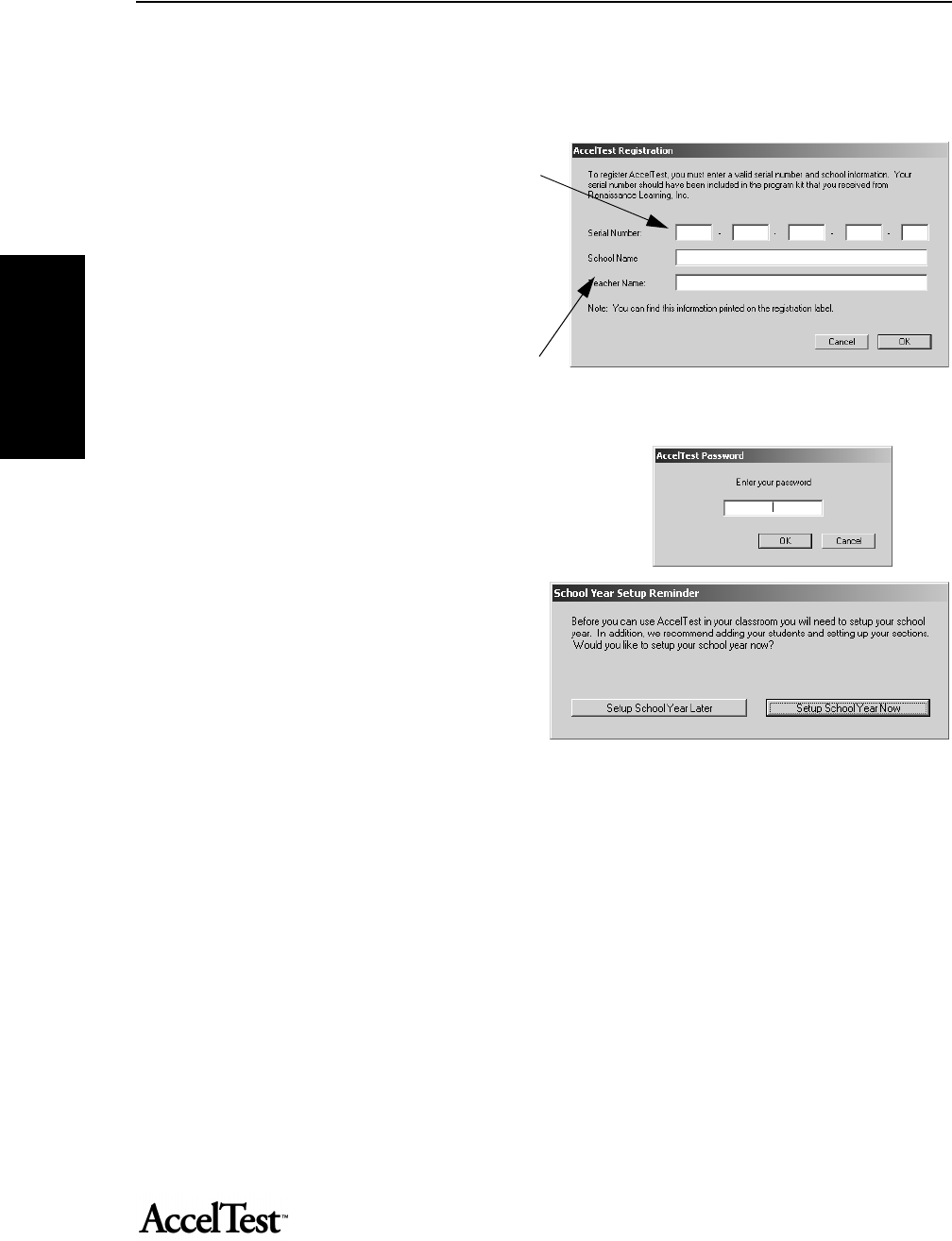
Installing AccelTest
8
Installing
AccelTest
If a window opens with a message indicating you do not have a default printer, you will not be able to
create AccelTest Assignments or print or preview reports until you get access to a printer and set it as your
default printer. After reading the message, click the [OK] button.
2. The AccelTest Registration dialog box
opens. Type the Serial Number in the boxes.
The serial number may be found on the sticker
located below the CDROM package on the
inside front cover of this manual, or on the one-
page instruction sheet you received with the
software. As you type the serial number, be
careful not to confuse “Z” and “2,” “I” and “1,”
“S“ and “5,” or “O” and “0.” Type in the school
name and your name in the boxes provided.
Then click the [OK] button.
3. When the AccelTest Password dialog box
appears, type admin in the text box. Click
[OK].
You will be asked if you would like to set up your
school year. Click [Setup School Year Now] to set
up your school year. The School Year Wizard
(Assistant in Mac) will start. See “Setting up
Your School Year” on page 10.
If you click [Setup School Year Later],
AccelTest’s Getting Started screen appears.
Before you start using AccelTest, you should
read and follow the suggestions in the “To-Do
List for Teachers Starting AccelTest” on page 9.
To learn more about how students can use the program, see “Student Instructions for Using AccelScan” on
page 19.
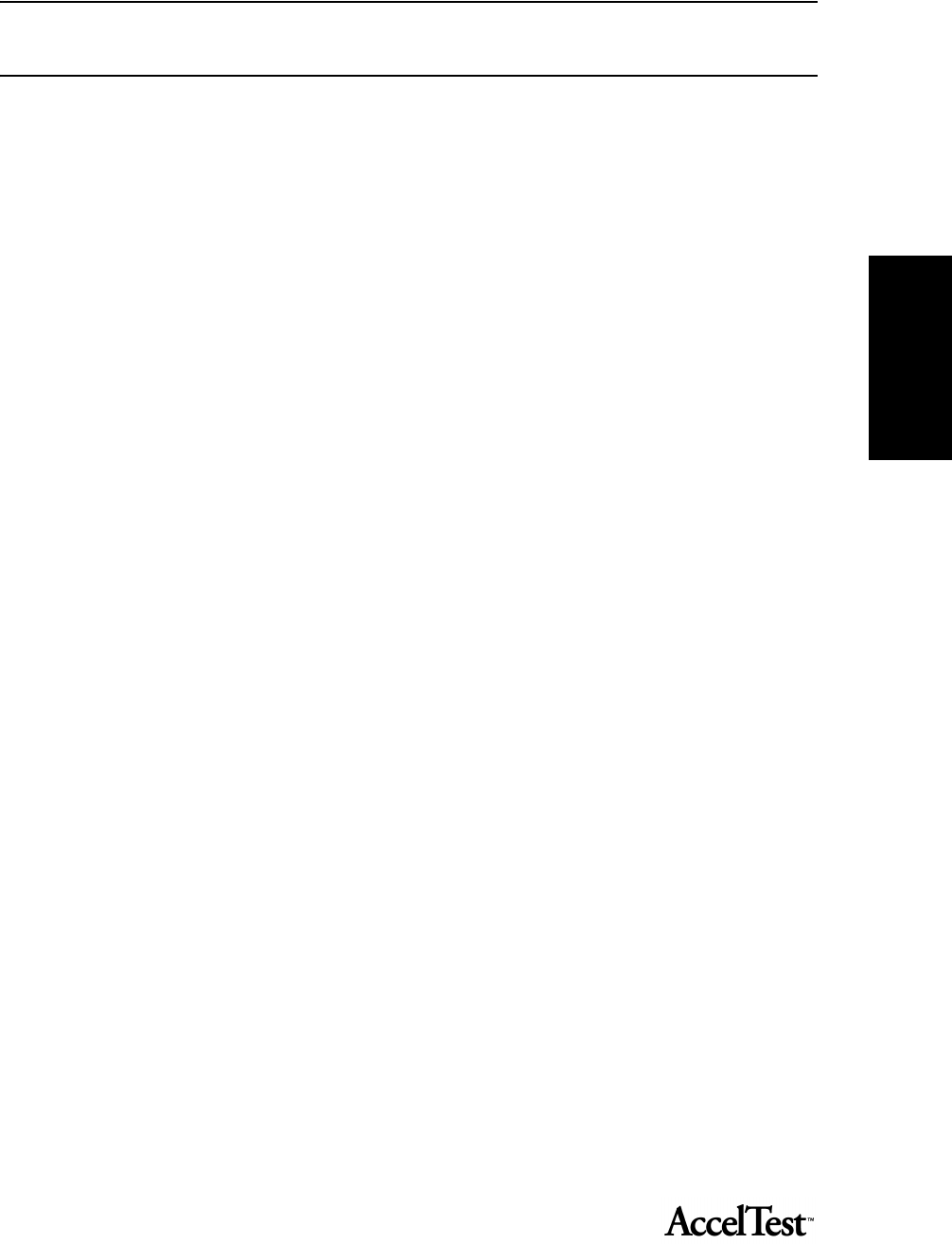
Installing AccelTest
9
Installing
AccelTest
To-Do List for Teachers Starting AccelTest
Once you’ve started AccelTest, you can start using it to create, import, modify, score and manage
assignments, as well as print or preview reports. However, before you start using AccelTest, you should
complete the following steps so that you can take full advantage of AccelTest’s features.
1. Set up your school year information so that AccelTest can include it in your assignments automatically.
As you type in your school year information, you will be prompted to set up your terms and semesters.
For an introduction to the School Year preference, see page 50. For detailed instructions, see “Setting up Your
School Year” on page 10.
2. Set up your class sections. See“New Section” on page 39.
3. Add or import your students. See “New Students” on page 34.
4. Review the Subjects preference, and if necessary, add to or edit the subject list. For an introduction to this
preference, see “Subjects” on page 50. For detailed instructions, see “Editing the Subjects List” on page 11.
5. Look at the Category preference, and edit categories or add categories to fit the subjects you teach. You can
decide weights for categories, if a category’s worst score should be dropped, how to calculate grades, etc.
For an introduction to this preference, see “Categories” on page 51. For detailed instructions, see “Setting
Category Values” on page 12.
6. Review the Grading Scale preference. You will want to change the Grading Scale to fit your grading
system. For an introduction to this preference, see “Grading Scale” on page 51. You can find detailed
information on “Setting Grading Scales” on page 12.
7. Look at the Exams preference. You may want to adjust the percent and marking period the grade applies to.
For an introduction to this preference, refer to “Exams” on page 51. For detailed instructions, see “Setting
Exams Preference” on page 13.
8. Now you can start to work with AccelTest. See “Two Ways to use AccelTest” on page 14.
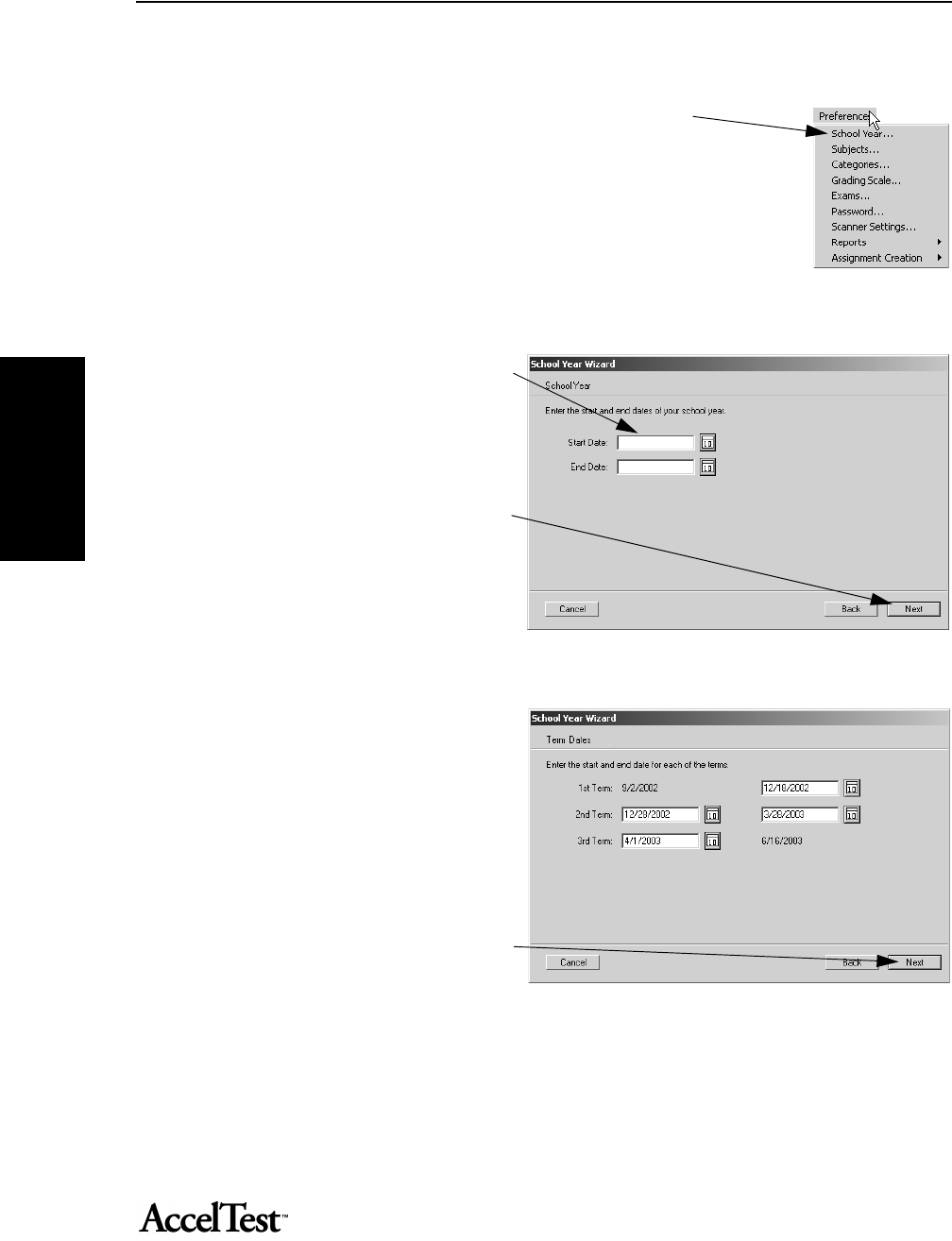
Starting Acceltest
10
Starting
AccelTest
Setting up Your School Year
1. Click on the Preferences drop-down menu, and click on School Year.
The School Year Wizard (Assistant on Macintosh computers) starts.
In the Welcome screen click [Next].
2. In the School Year dialog box, type in your Start Date and End Date.
(Hint: If you want to see a calendar, click on
the calendar icons next to the Start and End
date boxes. Use the arrows to select the
year, and click on the month, then click on
the day to enter the Start Date and End
Dates.)
Click [Next] after you enter your dates.
3. Select the number of terms in the Terms drop-down menu in the Number of Terms dialog box.
4. In AccelTest, you will use Term to define
blocks of time in the school year. You can
select up to six terms.
If you select two or more terms, you can
choose to group them into a semester.
Type in each Term start date or click the
calendar icons to enter the term start and
end dates in the Term Dates dialog box.
Click [Next] after you enter your dates.
5. Review the information you have entered in the Summary dialog box. Click [Back] if you need to correct any
errors; then, click [Done].
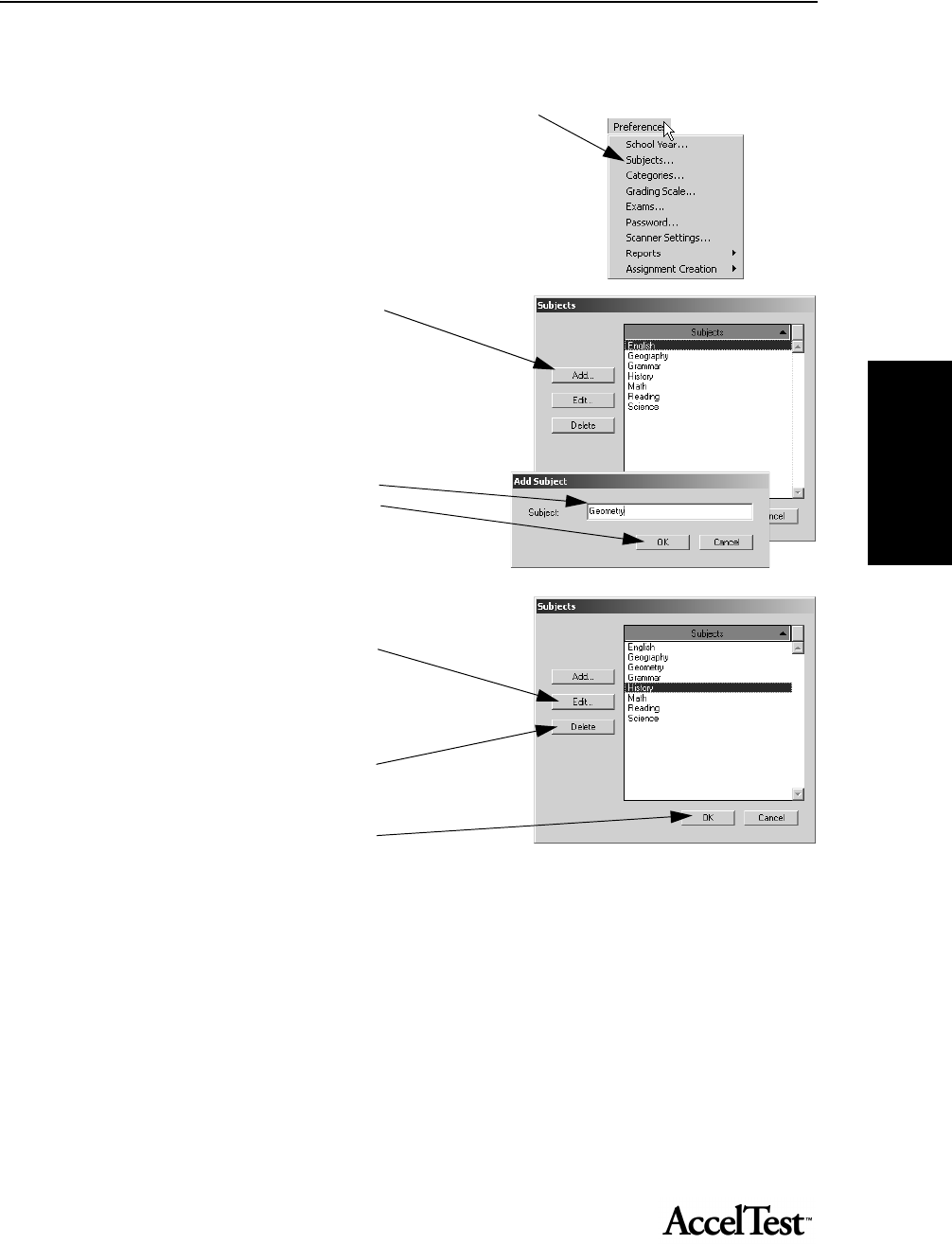
Starting AccelTest
11
Starting
AccelTest
Editing the Subjects List
1. Click on the Preferences drop-down menu, and click on Subjects.
2. In the Subjects dialog box, click on [Add]
to add a subject.
In the Add Subject dialog box, type the
name of your subject. Click [OK].
3. If you need to edit the name of a subject,
click on the subject and then click [Edit].
Make your change and click [OK].
If you want to keep your subject list short
as you add more subjects, click on the
unused subjects and then click [delete].
When you finish adding, editing or
deleting, click [OK].
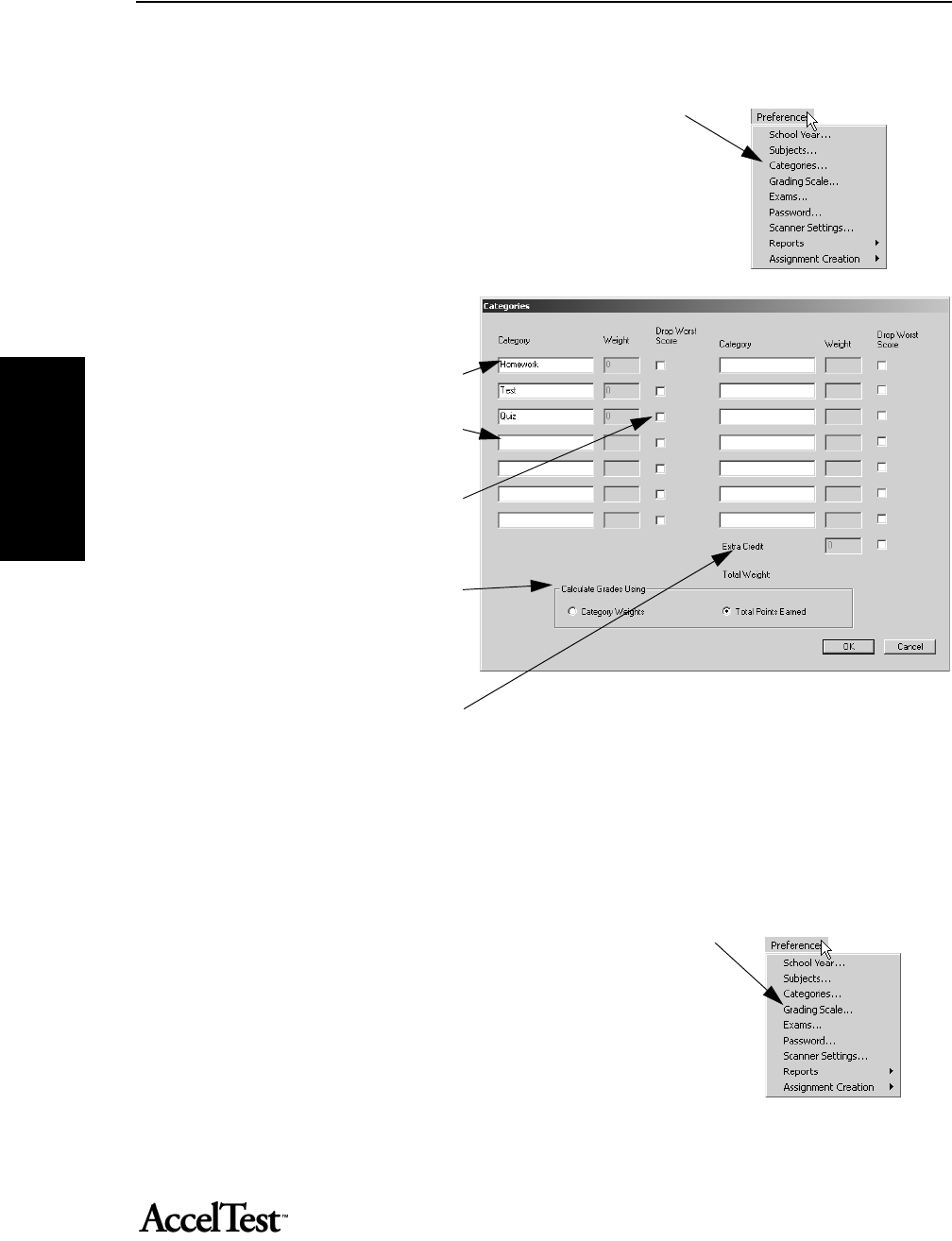
Starting Acceltest
12
Starting
AccelTest
Setting Category Values
1. Click on the Preferences drop-down menu, and click on Categories.
2. The Categories dialog box opens.
If you need to edit an existing
category, click in the box, and type
your changes.
You can type in a new category in a
blank field, if needed.
Click on the Drop Worst Score box,
where applicable.
In the Calculate Grades Using
section, select Category Weights or
leave Total Points Earned selected.
Edit or type in a Weight value (if
using category weights).
Don’t forget Extra Credit, if used.
Note: For more information on category weights, extra credit and grade calculation,
see “Appendix: AccelTest’s Grade Calculations” on page 89.
3. When you have finished adding or changing your category preferences, click the [OK] button.
Setting Grading Scales
1. Click on the Preferences drop-down menu, and click on Grading Scale.
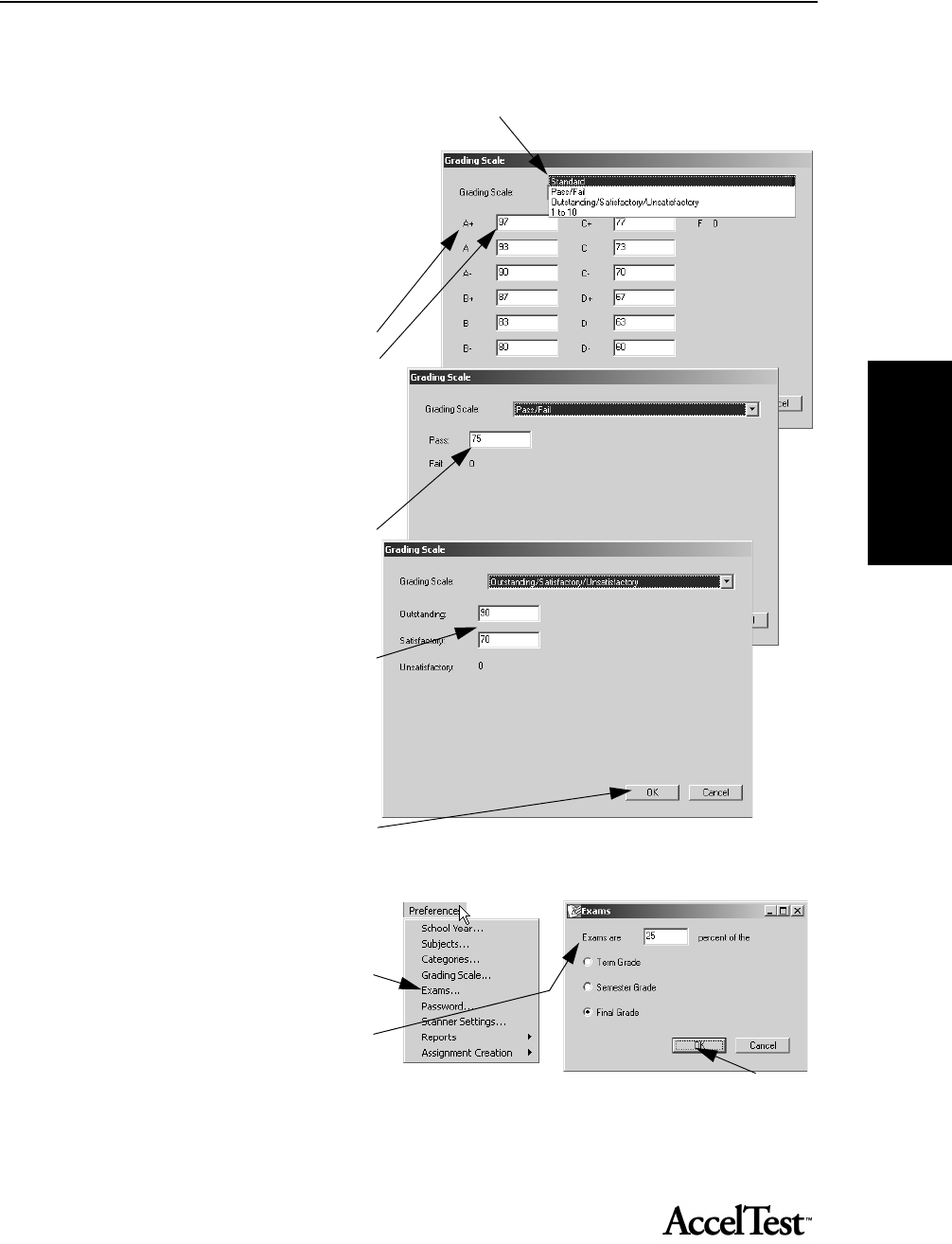
Starting AccelTest
13
Starting
AccelTest
2. The Grading Scale dialog box opens showing the Standard grading scale. If you are not using a standard
grading scale, choose another option from the Grading Scale drop-down list.
If you are using a standard grading scale,
you can determine the minimum
percentage needed for each letter grade by
clicking the box and changing the number.
Note: The number you type is the minimum
percent necessary to obtain that letter
grade.
For example, if your grading scale does not
use the A+ as a letter grade you can leave
the box next to A+ blank. This can be done
for any letters not used in your grading
system.
If you selected Pass/Fail, in the dialog box,
you can change the percentage delineating
pass/fail. Click in the box next to Pass to
enter the new number.
For the Outstanding/Satisfactory/
Unsatisfactory option, you can change the
percentage delineating Outstanding and
Satisfactory in the boxes next to each.
The 1 to 10 grading scale is used
internationally and automatically assigns a
number grade of 1 - 10 depending upon the
percentage earned.
3. When you have finished changing your
grading scale preference, click the [OK] button.
Setting Exams Preference
1. Click on the Preferences drop-down menu,
and click on Exams.
2. In the Exams dialog box, you can edit the
percent that exams count toward either a
Term Grade, Semester Grade, or Final Grade.
The Term and Semester selections available will vary according to School Year preference settings. Click [OK]
when you are finished.
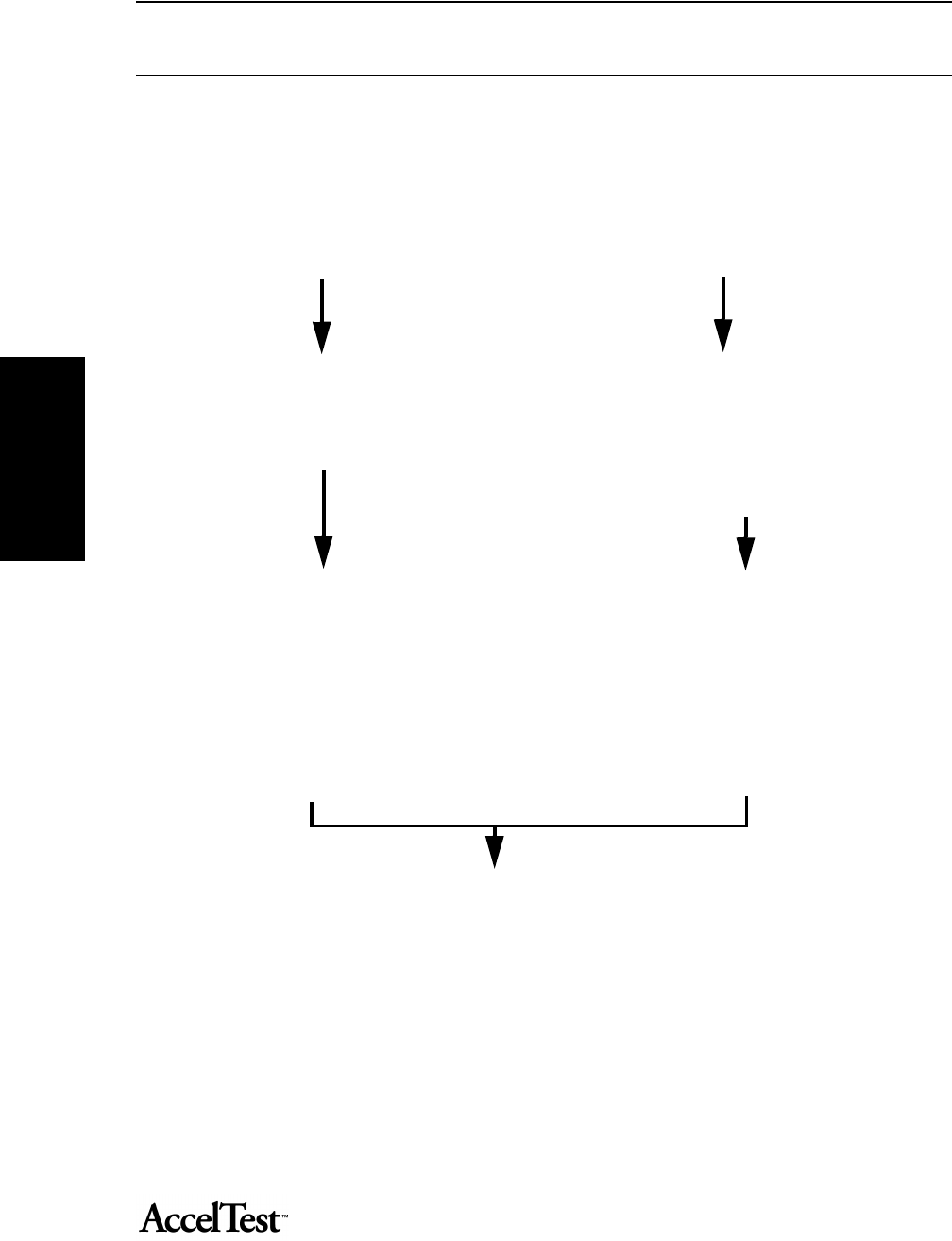
Starting Acceltest
14
Starting
AccelTest
Two Ways to use AccelTest
Second Example:
I have existing assignments,
such as quizzes, tests, exams,
and homework, that I want to be
able to quickly score and grade.
Step 1:
Create answer keys in AccelTest
to score and record grades. See
“Creating New Score Key for
Existing Assignment” on
page 66.
Step 2
Use the Gradebook to give assignment to students.
See “Add Assignments to Gradebook and Assign to
Students” on page 21.
Use the Gradebook to print assignments for students.
See“Printing Assignments for Students” on page 25.
Distribute AccelTest assignment copies.
First Example:
I need to create new assignments, such
as quizzes, tests, exams, and home-
work, that I want to be able to quickly
score and grade.
Step 1:
Create assignments using the Assign-
ment Editor. See “Creating Questions
for a New Assignment” on page 64.
Step 2
Use the Gradebook to give
assignment to students. See
“Add Assignments to Gradebook
and Assign to Students” on
page 21.
Distribute your existing
assignment.
Prepare AccelTest for student scoring. See “Preparing AccelTest for Students to Score Scan
Cards” on page 16. Have students score their completed assignments.
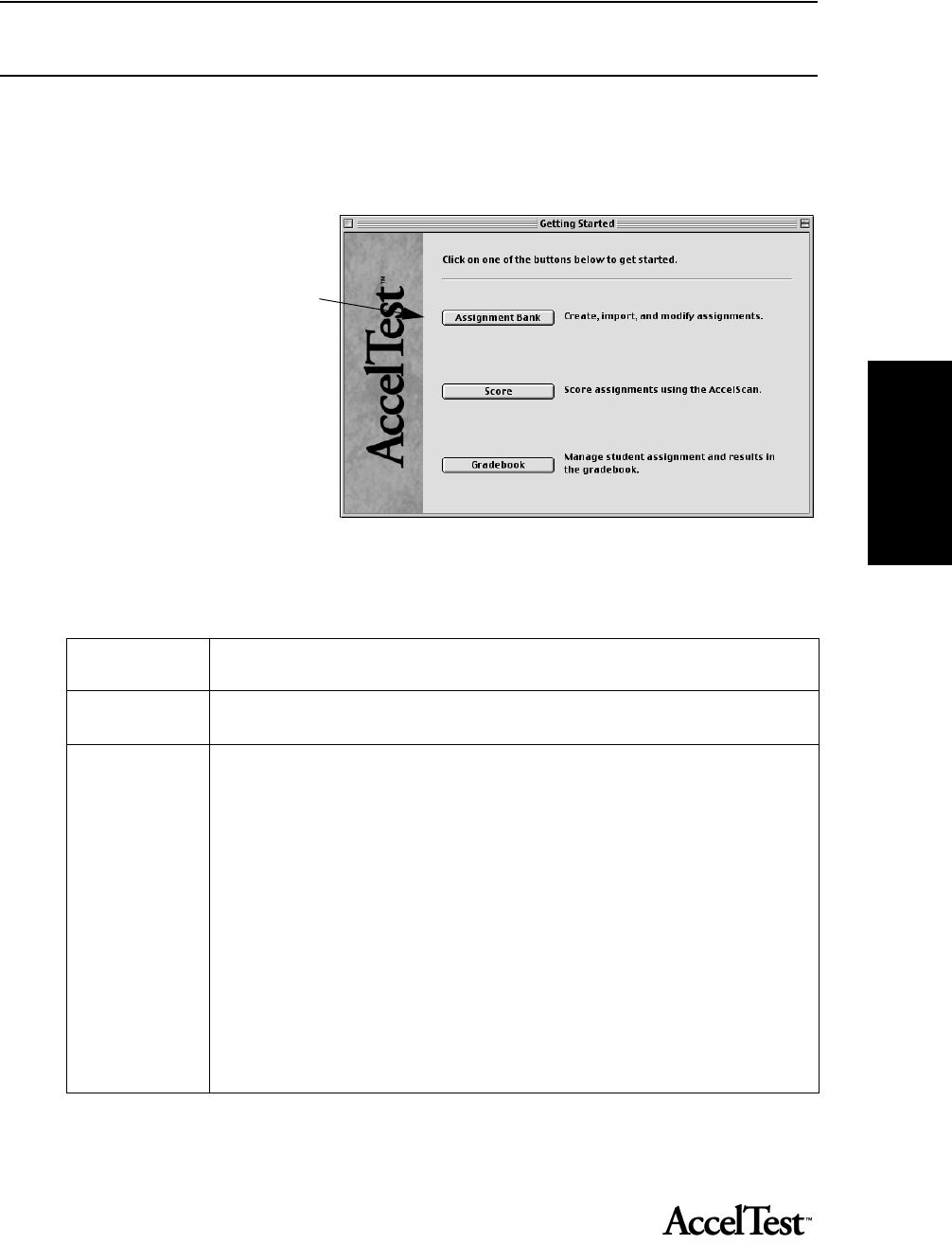
Starting AccelTest
15
Starting
AccelTest
Getting to Know AccelTest
The main AccelTest screen has four tabs: Gradebook, Assignments, Libraries, and Sessions. You
can click on a tab to go to the AccelTest function indicated on the button.
Assignment
Clicking on the Assignment tab
starts the following process to
create and assign tests, quizzes and
homework, etc.
• You create assignments to
give to your students. You
determine the item (question)
type, number, and point
value.
• You create an AccelScan score
key to automate the scoring of your existing assignments.
The AccelTest program default Category, Subject, and Item choices are shown in the table below.
For detailed information see “Using Assignments” on page 63.
Category •Quiz •Test •Homework
Teacher defines additional Categories.
Subjects •English •Math •History •Reading •Geography •Science •Grammar
Teacher defines additional Subjects.
Item (question)
Types
Assisted Response, which includes:
• MC - Multiple Choice
• M - Matching
• R - Ranking
• TF - True/False
• YN - Yes/No
Free Response, which includes:
• E - Essay
• F - Fill in the Blank
• MTF - Modified True/False
• SA - Short Answer
• NR - Numeric Response
Teacher defines number of items and point value for both Assisted Response and Free
Response Item Types.
Replace
with 4 tabs
panel
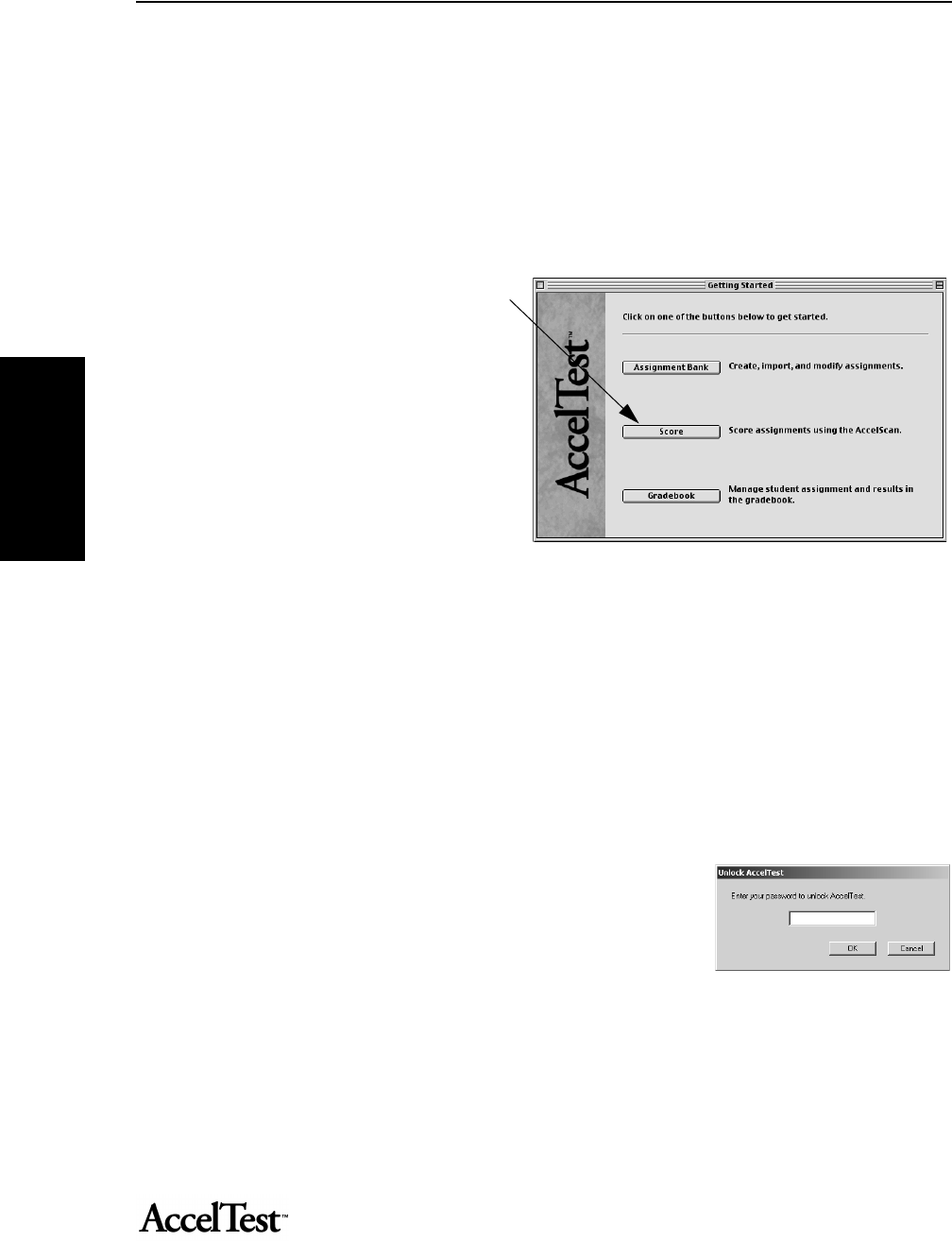
Starting Acceltest
16
Starting
AccelTest
Score
Before you can score any scan cards in AccelTest, you must install and connect the AccelScan
scanner. See the AccelTest and Renaissance Classroom Response System Installation Guide.
You must create an assignment or create a score key for an existing assignment.
To create an assignment, see “Creating Questions for a New Assignment” on page 64.
To create a score key, see “Creating New Score Key for Existing Assignment” on page 66.
The Score button in the Getting Started
screen permits students to use of the
AccelScan card reader to score the
assignments. See “Student Instructions for
Using AccelScan” on page 19. Teachers
can score the scan cards. See “Teacher
Instructions for Scoring Student
Assignments” on page 30. In both cases,
AccelTest records student grades.
Preparing AccelTest for Students to Score Scan Cards
To prepare AccelTest for student scoring of their scan cards, simply click [Score] in the Getting
Started screen. (Do not start scoring from the Gradebook to prevent unauthorized access to
AccelTest.)
Instructions that you can copy for students to use for scoring are found in“Student Instructions
for Using AccelScan” on page 19.
Note: Once you click on [Score], the application locks, and the students will not be able to
access any other part of the program.
Password to Unlock AccelTest
To return to AccelTest from student scoring, you must enter
the AccelTest password in the “Enter your password to unlock
AccelTest” box in the Unlock AccelTest screen. Then click
[OK]. Your default password is admin.To change the password, use the Password Preference;
see page 52.
Replace
with 4 tabs
panel

Starting AccelTest
17
Starting
AccelTest
Student instructions for using the Classroom Responder
AccelTest software and the Classroom Receiver and Classroom Responder must both be installed
and confiured before teachers and students can start using the Classroom Responder. For
installation and set up instructions, see AccelTest and Renaissance Classroom Response System
Installation Instructions.
1.
2.
3.
4.
5.

Starting Acceltest
18
Starting
AccelTest
6.
7.
8.
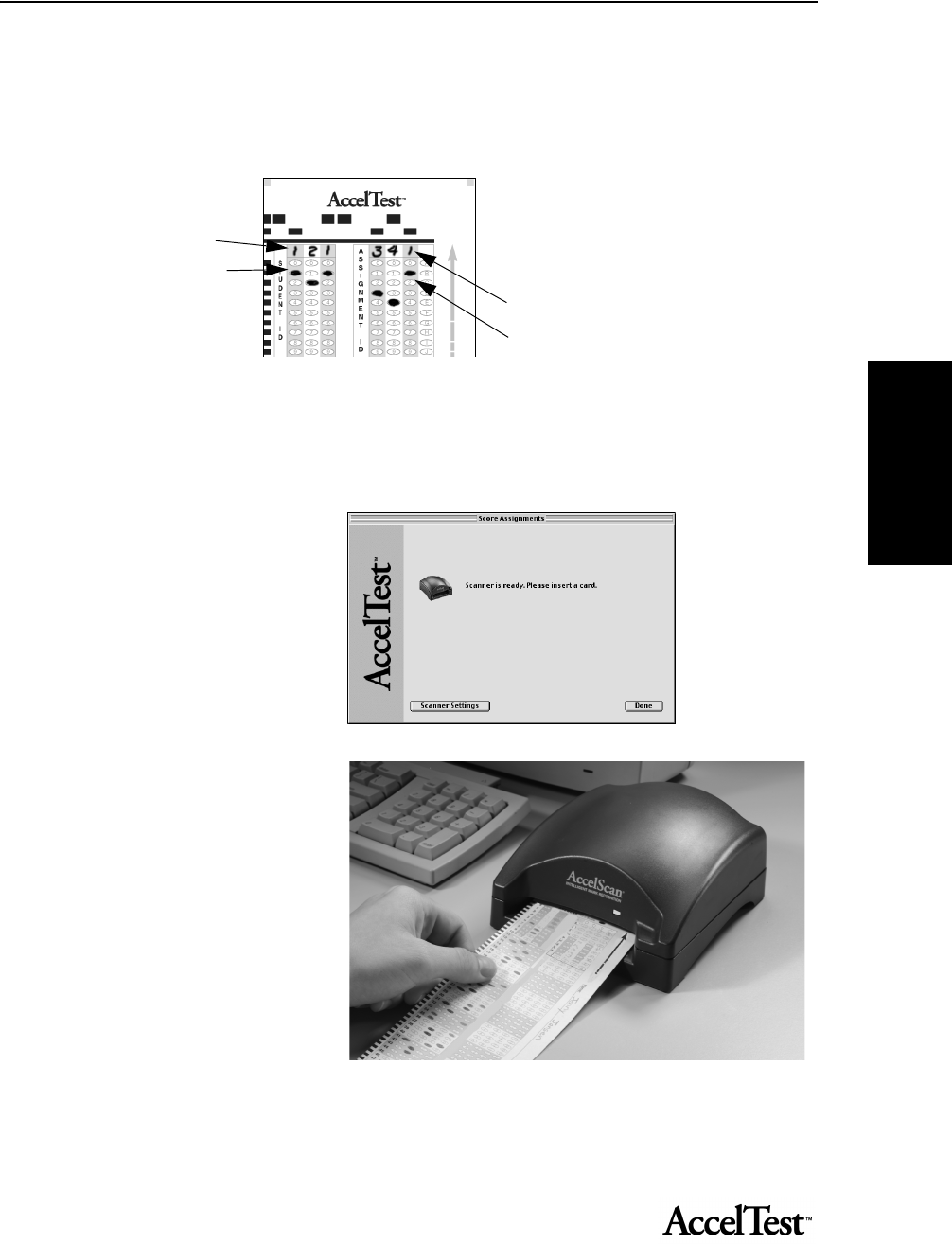
Starting AccelTest
19
Starting
AccelTest
Student Instructions for Using AccelScan
1.Be sure that you filled in your three-digit Student ID number and Assignment ID number (and letter, if used)
at the top of the scan card. Fill in a bubble underneath each number (or letter).
2.Check over your AccelScan scan card.
*Make sure that all answers have been filled in and marked next to the correct problem numbers.
*Erase any stray marks.
*If any answers were changed, be sure the old answers are completely erased.
3.The Score Assignments screen
shows that the scanner is ready.
4.Insert the scan card into the scanner
face up, with the scan card number
and arrow going into the scanner first.
5.The scanner will take the scan card
and score the assignment. The
message saying the scanner is ready
will appear again. If AccelScan cannot
read your scan card a message will
tell you to see your teacher.
6.Your card will be behind the
scanner. Save it so you can use the
other side.
Fill in the Assignment ID numbers
(and letter, if used).
Fill in the bubbles under each digit
(or letter, if used).
Fill in the Student ID numbers.
Fill in the bubbles under each digit.
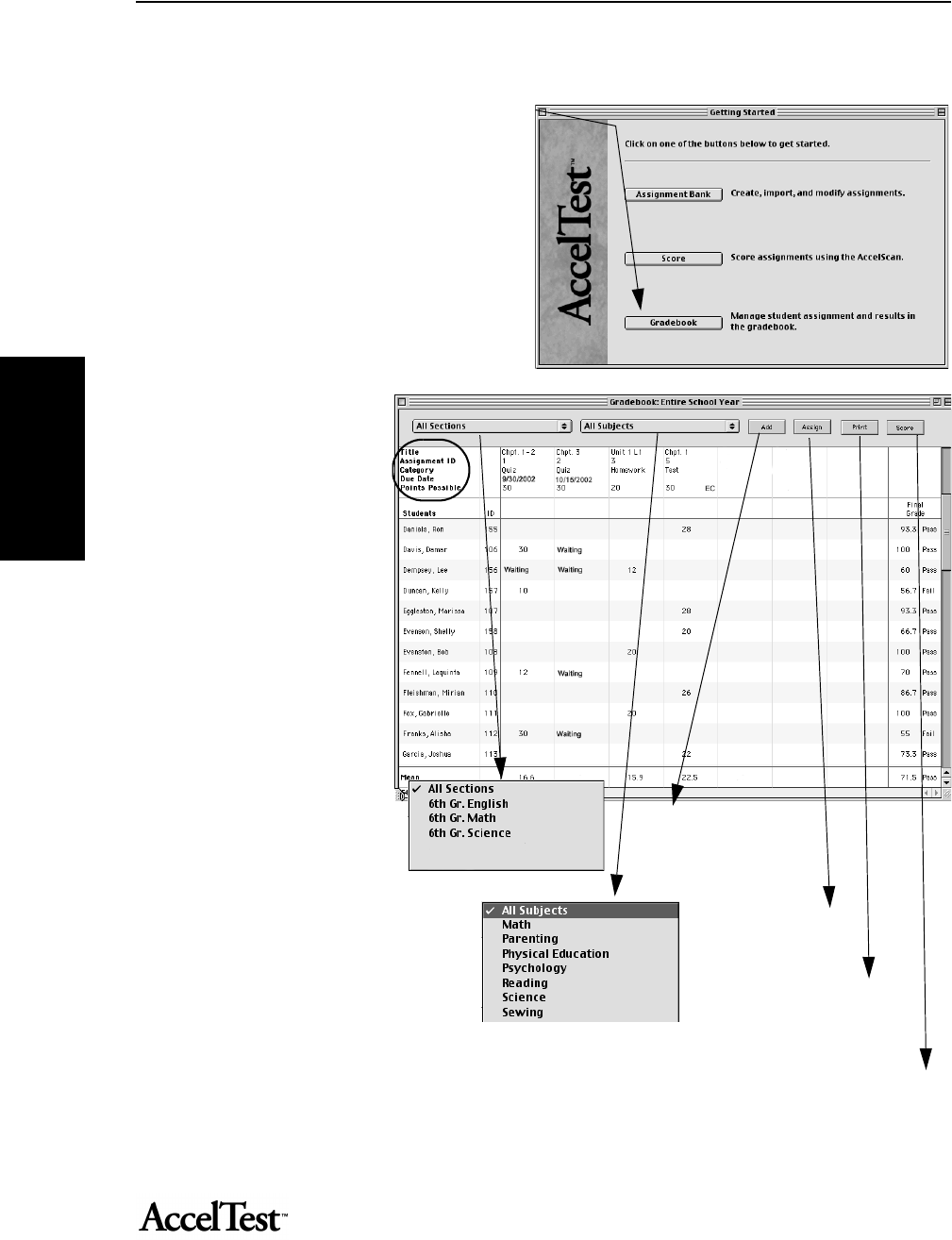
Starting Acceltest
20
Starting
AccelTest
Gradebook
The Gradebook displays assignments,
showing student, section, subject and grade
information for the teacher to view, edit,
and manage.
The Assignment Title,
Assignment ID,
Category, Due Date
and Points Possible are
shown for each
assignment.
The Gradebook is
where assignments
created in the
Assignment tab are
added so they can be
assigned to class sections
and groups of students.
See “Add Assignments
to Gradebook and
Assign to Students” on
page 21.
Giving an assignment to
an individual student is
easy in the AccelTest
Gradebook. See
“Assignments for
Individual Students” on
page 23.
Replace
with 4 tabs
panel
See “Add Assignments
to Gradebook and
Assign to Students” on
page 21.
See “Assignments for
Individual Students” on
page 23.
See ????????????
Was Using Score
See “Printing
Assignments for
Students” on
page 25.
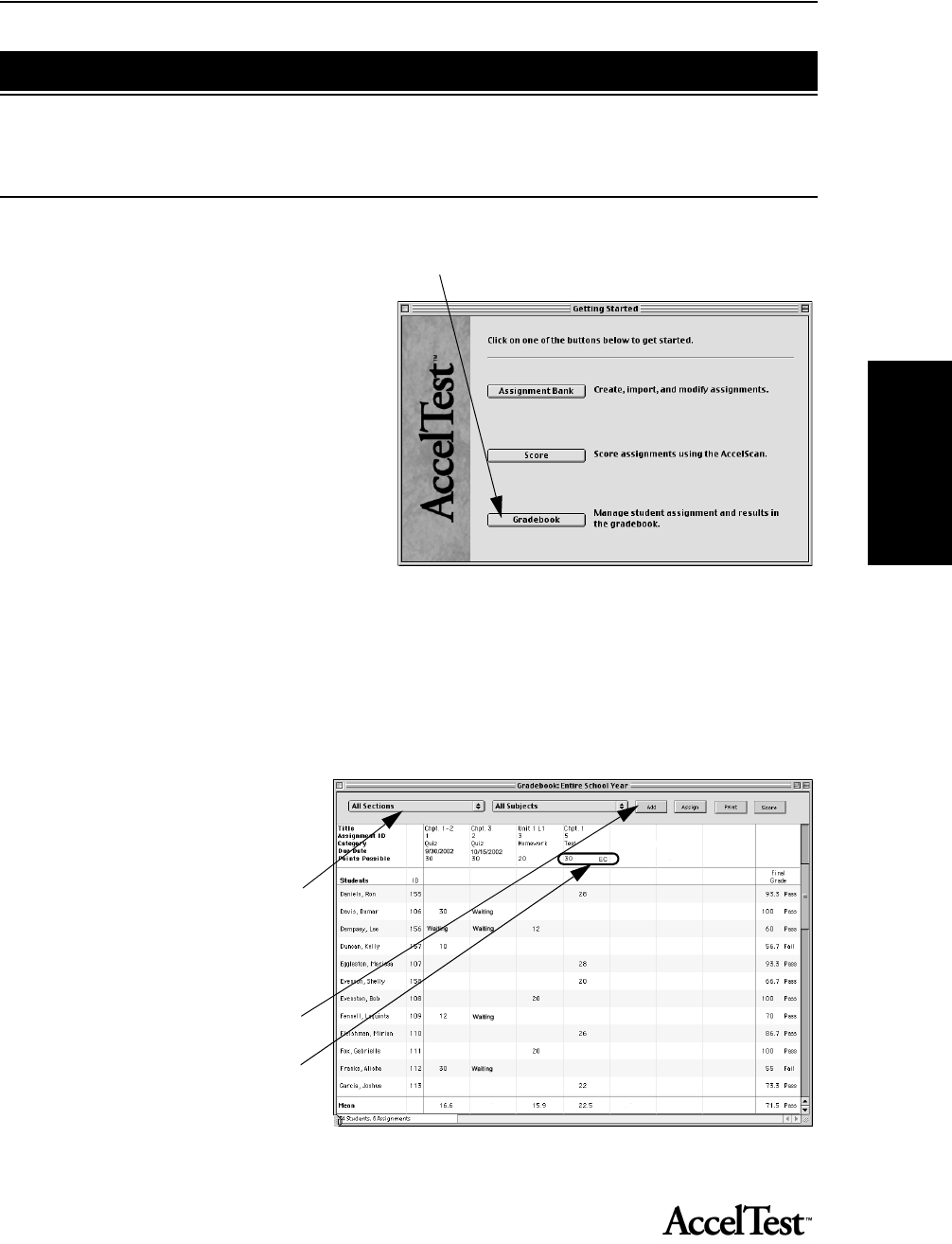
Starting AccelTest
21
Starting
AccelTest
Frequently used Gradebook Features
Clicking on the [Gradebook] button opens the Gradebook.
The teacher can add (or import) students in
Gradebook.
The Gradebook allows the teacher to use
drop-down menus to switch between
different sections of students or different
subjects.
The Gradebook contains information on
assignment title, id, category, due date, and
points possible. The teacher uses Gradebook
to give assignments to sections, groups of
students or individual students.
Add Assignments to Gradebook and Assign to Students
The Add Assignment Wizard or Assistant helps you add to the Gradebook, assignments that you
have created in the Assignment tab. Once they are recorded in the Gradebook, the Add Wizard/
Assistant helps designate assignments for sections, groups of students and individual students.
1. Start AccelTest and click on the
[Gradebook] button in the
Getting Started screen. If you
want to select a Section, click on
the Sections drop-down menu
and click on the section.
To start the Add Assignment
Wizard/Assistant, in the
Gradebook screen, click on the
[Add] button.
Note: Extra Credit assignments
have EC after Points Possible in
the column head.
Using Gradebook
Replace
with 4 tabs
panel
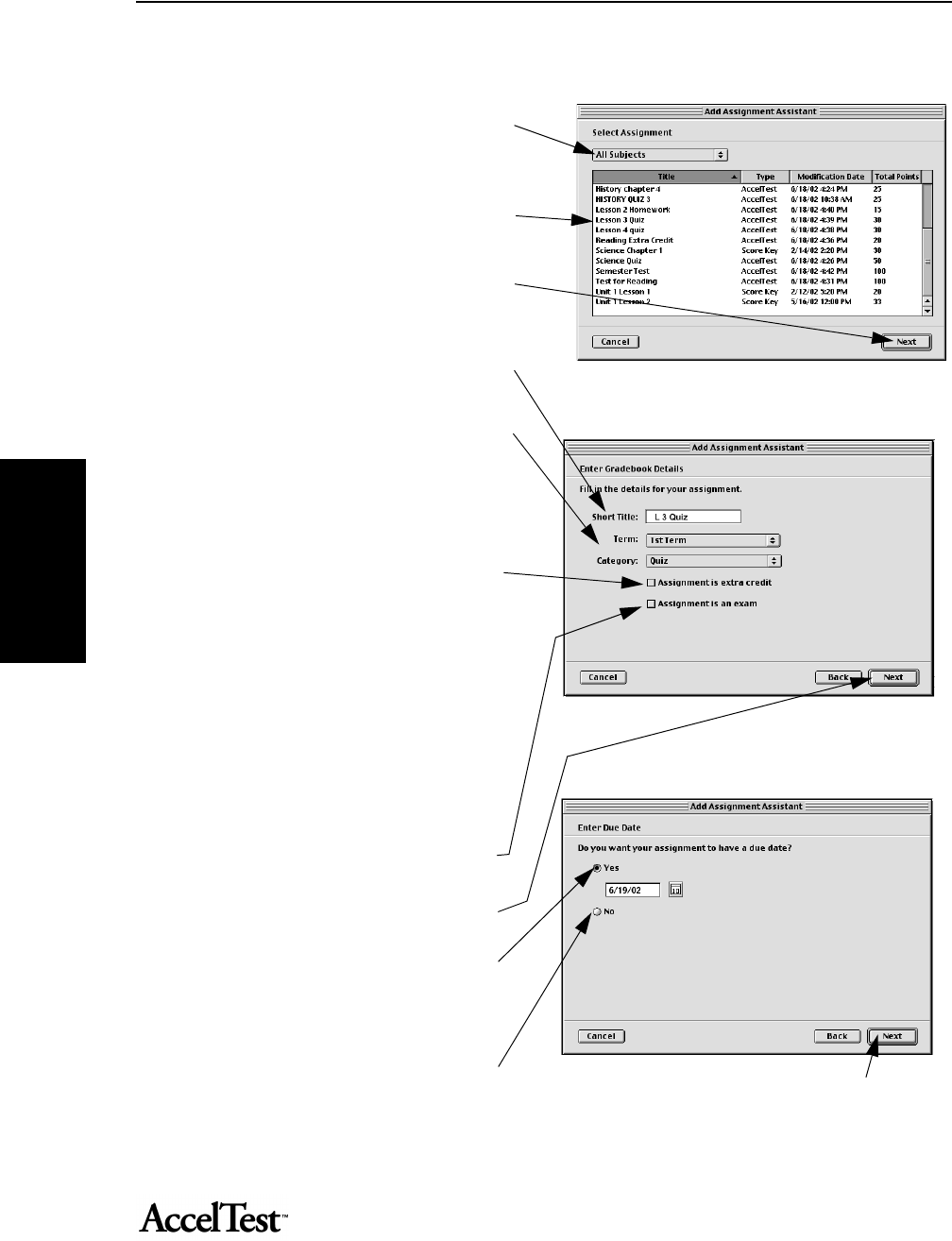
Assignment
22
Assignment
2. In the Select Assignment screen, click
on the Select Assignment drop-down
menu and select your subject if you want
to limit the list of assignment titles by
subject.
Click on the assignment title you are
adding/assigning.
Click [Next].
In the Enter Gradebook Details dialog
box, enter a short title for your assignment
in the Short Title box.
Click on the term that applies in the Term
drop-down list, and the category in the
Category drop-down list. Category choices
are Homework, Test, Quiz, or Extra Credit.
If you want to make an assignment extra
credit, click on the box next to Assignment
is extra credit. (EC will appear next to
Points Possible in the Gradebook column.
See Note on preceding page.) Do not click
on Assignment is Extra Credit for an Extra
Credit category assignment. Note: For an
explanation of when to use Extra Credit
Category and when to check Assignment is
extra credit, see “Grade Calculations” on
page 90.
If it is an exam, click on the box next to
“Assignment is an exam.”
Click [Next] to continue.
3. In the Enter Due Date dialog box, click on
Yes if your assignment needs a due date.
Type in the date or click on the calendar
icon and click to select the year, month
and day the assignment is due. Click on No
if there is no due date. Note: If you do not enter
a due date for an assignment, AccelTest will not track it as a required Assignment. Click [Next] to continue.
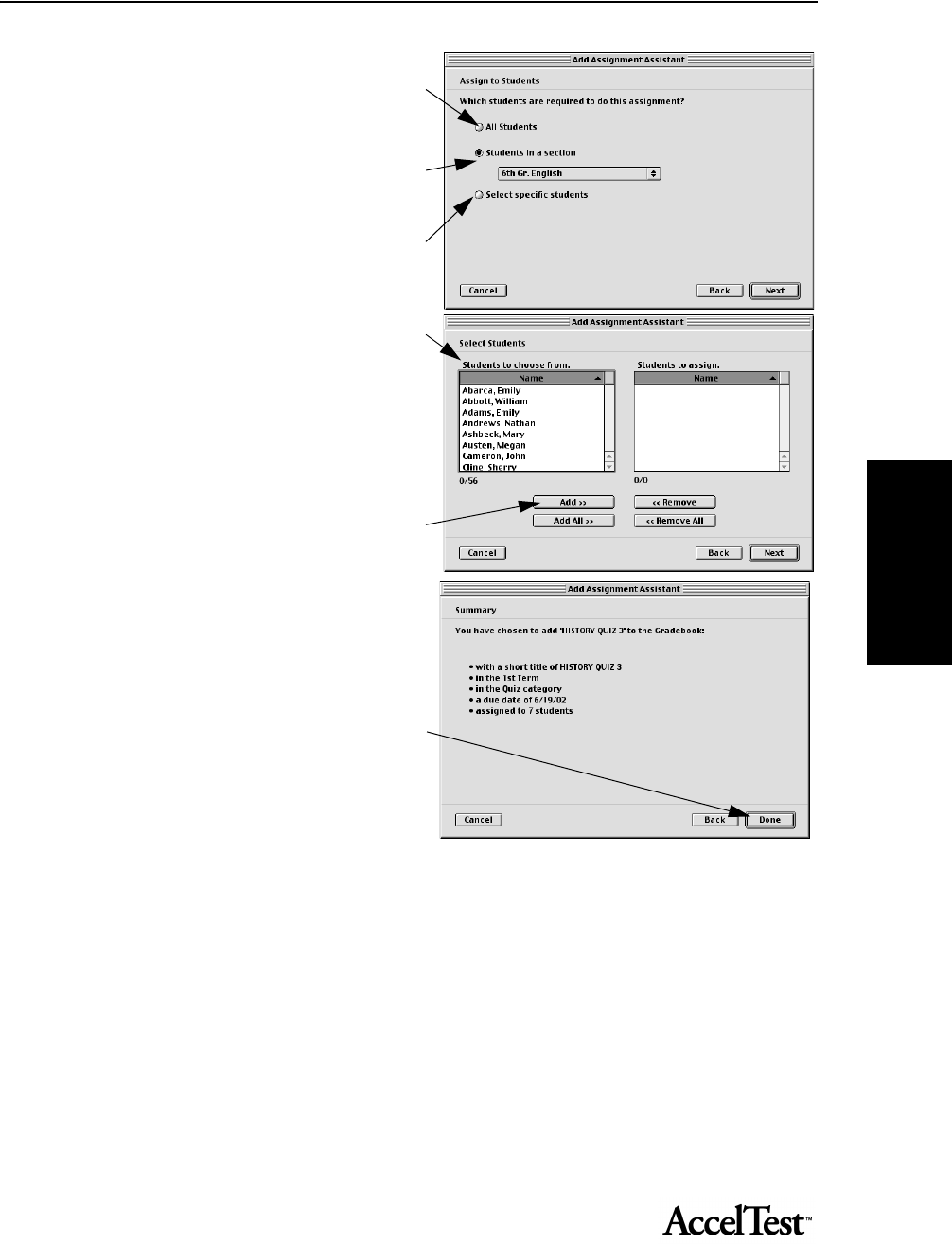
Assignment
23
Assignment
4. In the Assign to Students dialog box, click on “All
Students” if all students are required to do the
assignment.
To assign to the students in a section, click on
“Students in a section.” Then click on the section
name in the drop-down list.
To assign to individual students, click on “Select
specific students.”
5. In the Select Students dialog box, look in
“Students to choose from” to find your student(s).
Since you only want to add some of the
students, first hold down the <Ctrl> key (Windows)
or the <z> key (Macintosh) and then click on the
students you want to add. You can also select a
group of students by clicking on the first
student name, holding down the <Shift> key, and
clicking on the last student name. Click on the [Add]
button, then the [Next] button.
To add all of the students, click on the [Add All]
button, and then the [Next] button.
Check the information in the Summary screen.
Click [Back] to go back and make corrections.
If the information is correct, click [Done].
Your assignment will appear at the top of the
Gradebook screen, to the right of previously added
assignments. Students you have assigned this
assignment to, should show “Waiting” in the column under your new assignment.
Assignments for Individual Students
The Assign button allows you to quickly assign one or more assignments to individual or multiple
students. It is helpful when a new student joins a class in progress.
1. If the student is not in your school database, add or import the student. See“New Students” on page 34.
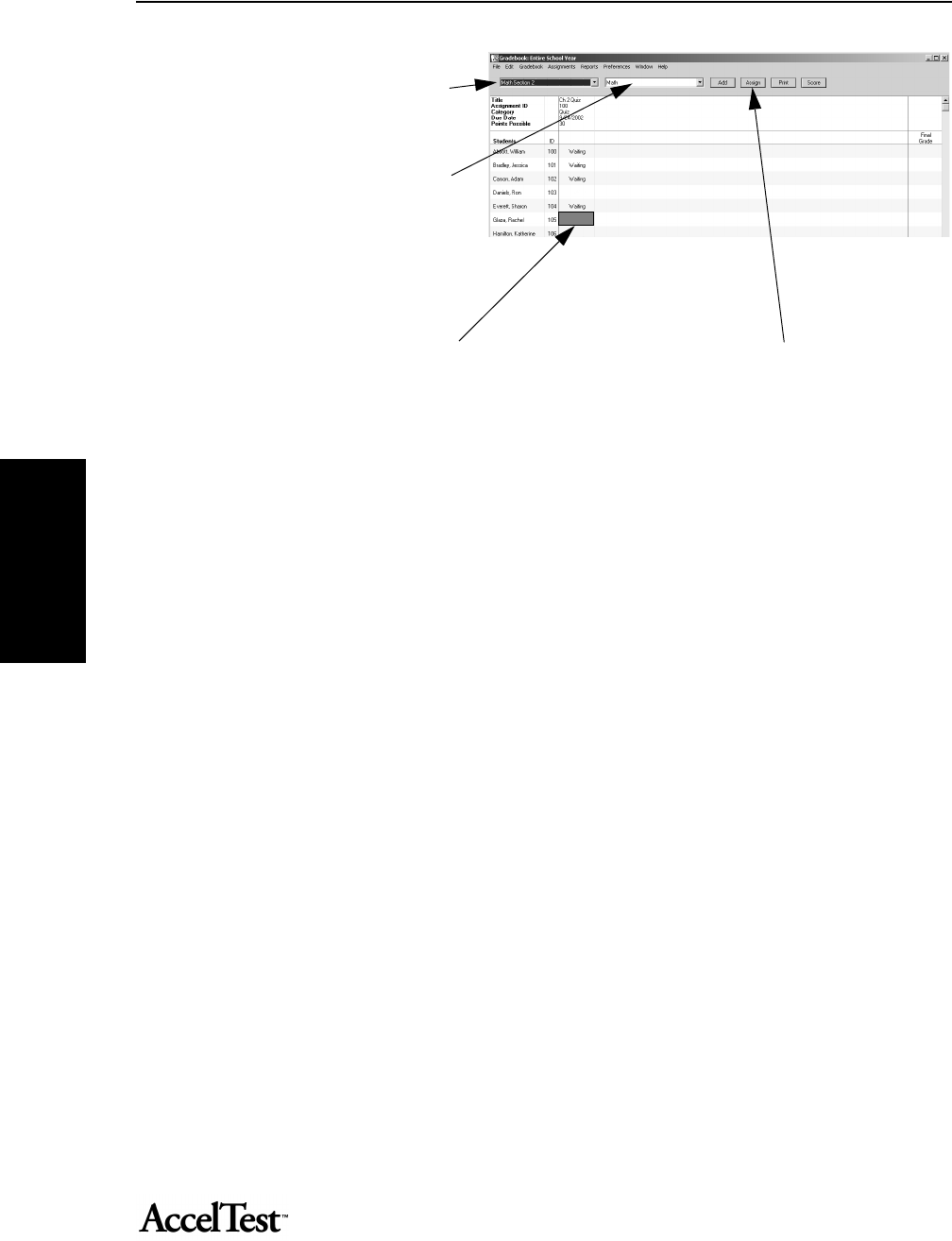
Assignment
24
Assignment
2. Next, from the Gradebook screen,
click on the Sections drop-down
menu and then click on the section
the new student is in.
3. In the Subject drop-down menu,
click on the subject.
4. Under Students, find the name of
the student you are adding.
In the assignment column, under
your assignment, click once in the
row with the name of the new student you are giving the assignment to. Then click on [Assign].
If you have more than one assignment to give to a student, click on the students name and all will be assigned.
You can give the assignment to all the students in the students column, by clicking on the assignment name.
Removing/Clearing Assignments in the Gradebook
To completely remove an assignment from the Gradebook, see Removing Assignments. To clear an
assignment from a student see Clearing Assignments.
Removing Assignments: If you want to remove an assignment that has been given to students, you
can do so by clicking on the column heading for the assignment, then, in the Gradebook drop-
down menu clicking on Remove. This will remove all student records for this assignment.
If this is OK, click [Yes] in the dialog box.
Clearing Assignments: You can clear assignments from individual students by clicking on the cell
in the assignment column after the students name and clicking on the Edit drop-down menu and
then clicking on Clear. This will remove student score data on this assignment for the student.
If this is OK, click [Yes] in the dialog box to clear the assignment.
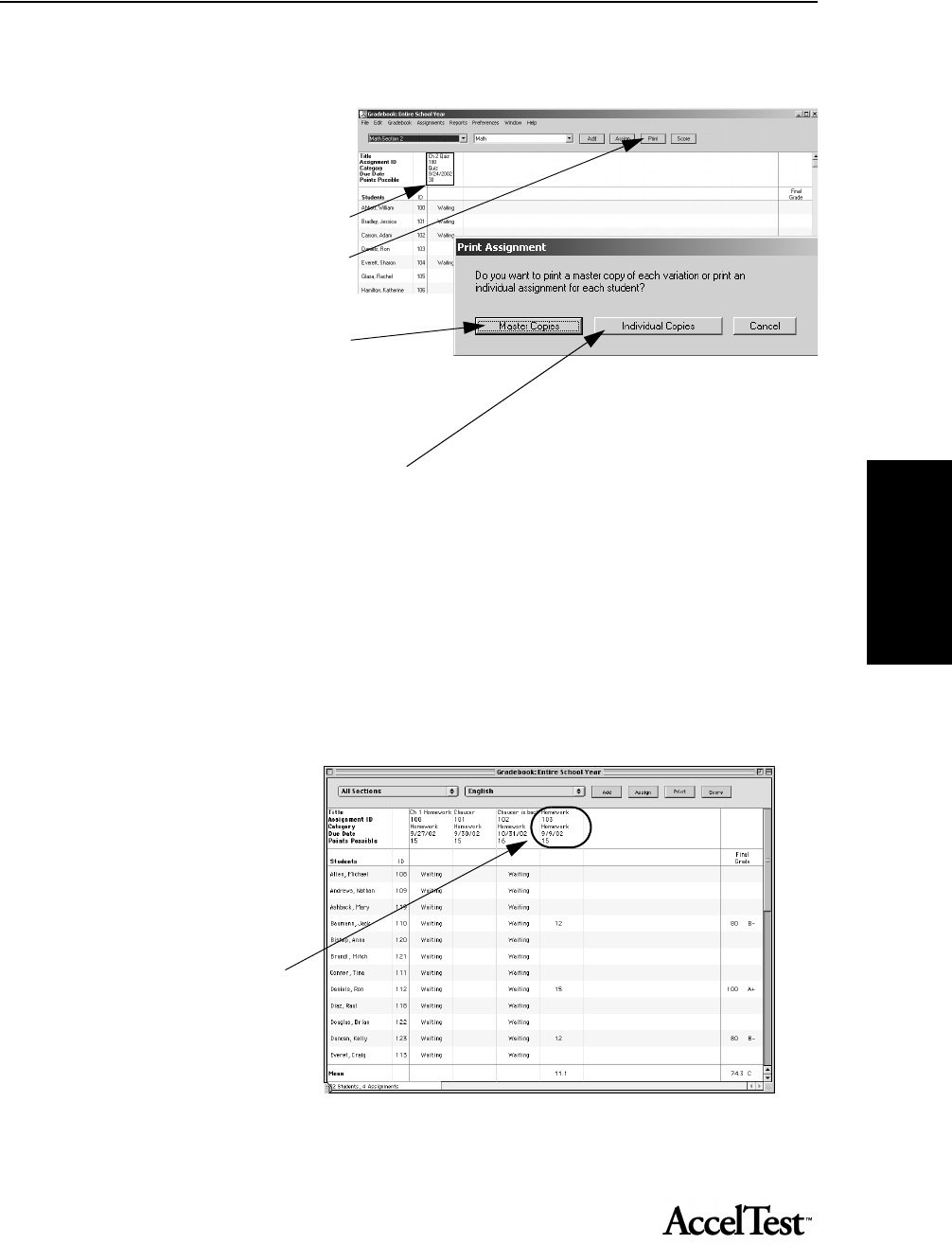
Assignment
25
Assignment
Printing Assignments for Students
From the Gradebook, you can print a
master for each assignment variation,
or print individual assignments for
each of your students.
From the Gradebook, click on the top
of the assignment column, then click
on [Print]. In the Print Assignment
dialog box:
• click on [Master Copies] to print
a master of each test variation.
Use this option if you would like
to duplicate your own copies of
the assignment to distribute.
• click on [Individual Copies] to print a single assignment for each student. Use this option to
print out all copies for distribution.
Viewing Assignment Item Scores in the Gradebook
Note: Only assignments that have been added to the Gradebook will appear in the Gradebook
screen. To edit and view more assignments (not yet in Gradebook), see “How to Use the
Assignment Editor” on page 74.
You can view assignment
points per item and see how
your students scored on items
(in completed and scored
assignments) in the
Gradebook.
1. From the Gradebook screen,
find the assignment you want
item information on. Double
click in the column heading
for the assignment.
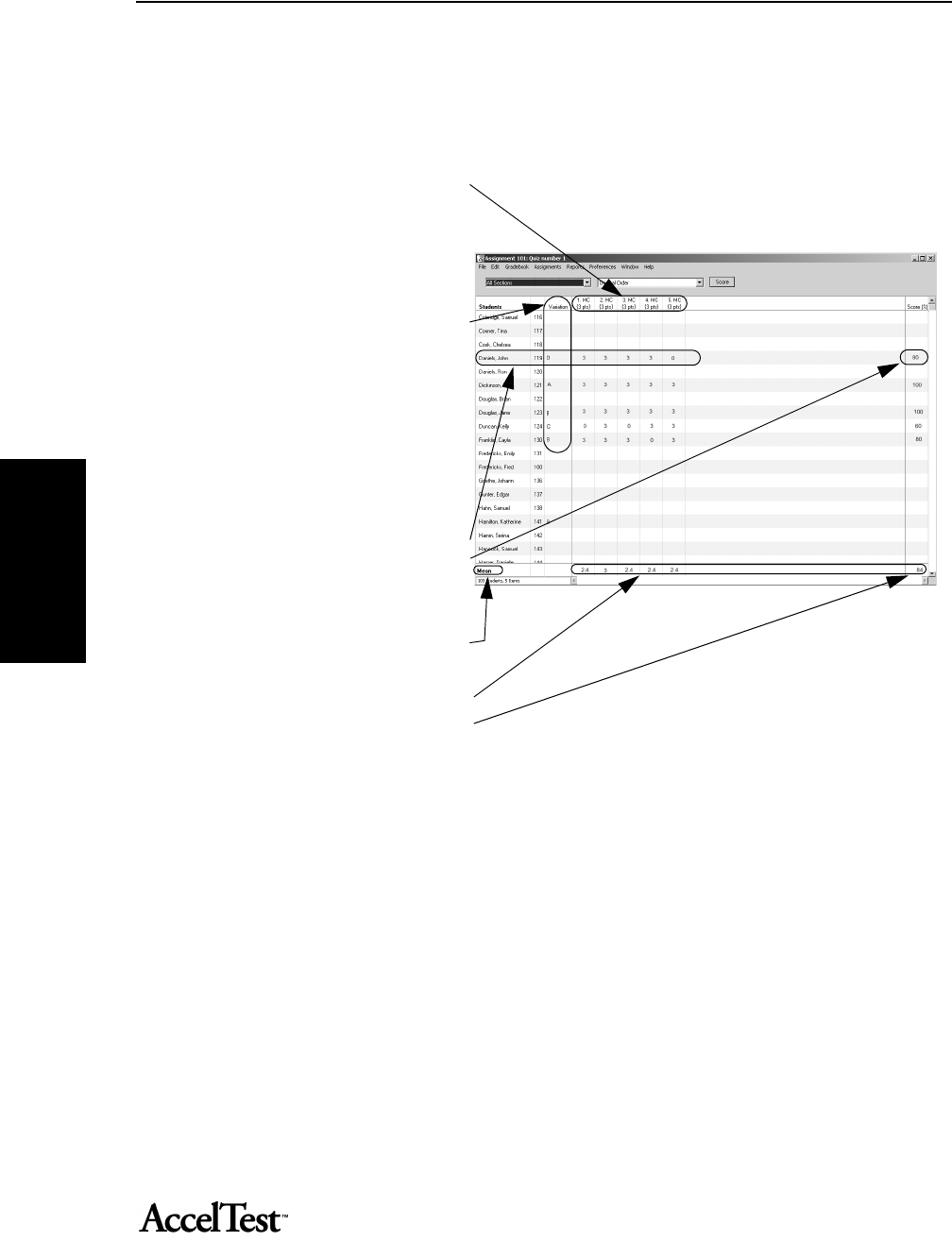
Assignment
26
Assignment
2. An expanded screen will open for the
selected assignment.
3. Notice that there is a column for each
item on your assignment. The points
per item and an abbreviation for the
item type are at the top of each
column. For an explanation of the item
abbreviations see “Creating Questions
for a New Assignment” on page 64.
4. The assignment Variation for each
student (whose card has been
scanned) is shown. You can select the
Variation view in the Variation drop-
down menu.
5. For assignments that have been
(scored), the points earned per item for
each student appears in the
columns. The points total for the
assignment per student is shown in
the Score column.
At the bottom, click on Mean or
Median to switch the view.
The mean points per item and mean
total score are shown at the bottom, in
this example.
6. To return to the Gradebook screen,
click [Done] or click on the File menu
and click Close.
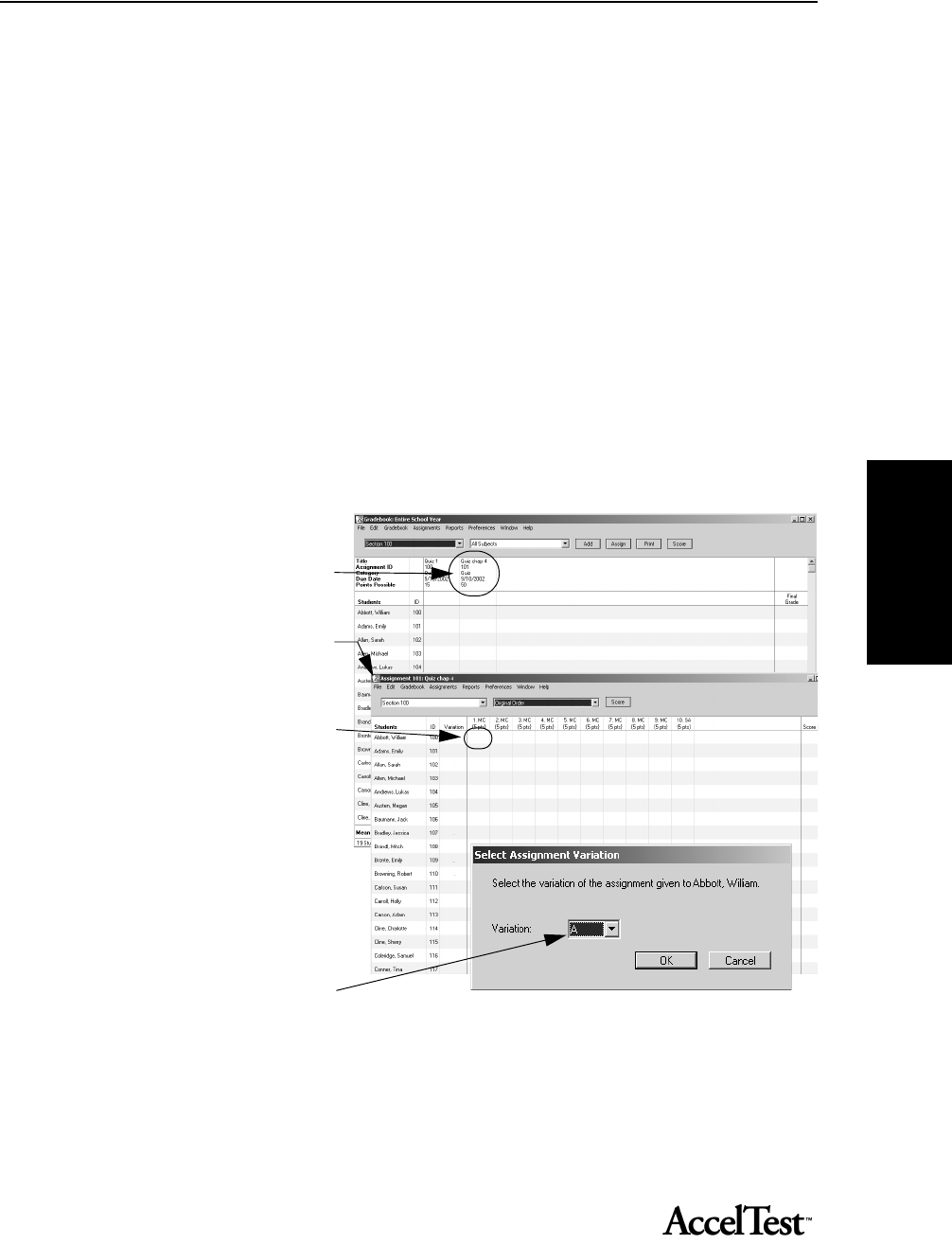
Assignment
27
Assignment
Scoring Assignment Items in the Gradebook
You can score and edit individual item points (for an assignment) in the Gradebook.
Note: Normally the easiest way to score student’s assignments is to scan the cards with the
AccelScan. If your students have not used AccelScan to score their own scan cards, you can scan
your students cards yourself. See “Using AccelScan from the Gradebook” on page 32.
The steps below, “Entering Scores at the Keyboard” describe how to enter student scores for
assisted response items from your computer keyboard. For information on how to edit
student scores that have been already been entered, see “Editing Scores at the Keyboard” on
page 28.
Note: If your assignment contains free response items, complete work on the assisted response items as
described below. Then you should refer to “Scoring Free Response Items” on page 30.
Entering Scores at the Keyboard
1. From the Gradebook screen, find the
assignment you want to score. Double
click in the column heading for the
assignment.
2. An expanded screen will open for the
selected assignment.
3. There is a column for each item on the
assignment. Double click in the first
space in the first column (first item).
If the default variation of 1 was
changed to 2 or higher, the Select
Assignment Variation dialog box
opens. (See “Variations” on page 59.)
Find the assignment variation on the
student assignment or scan card
where the student recorded the
answers. In the Variation drop-down
menu, click on the variation letter.
Click [OK].
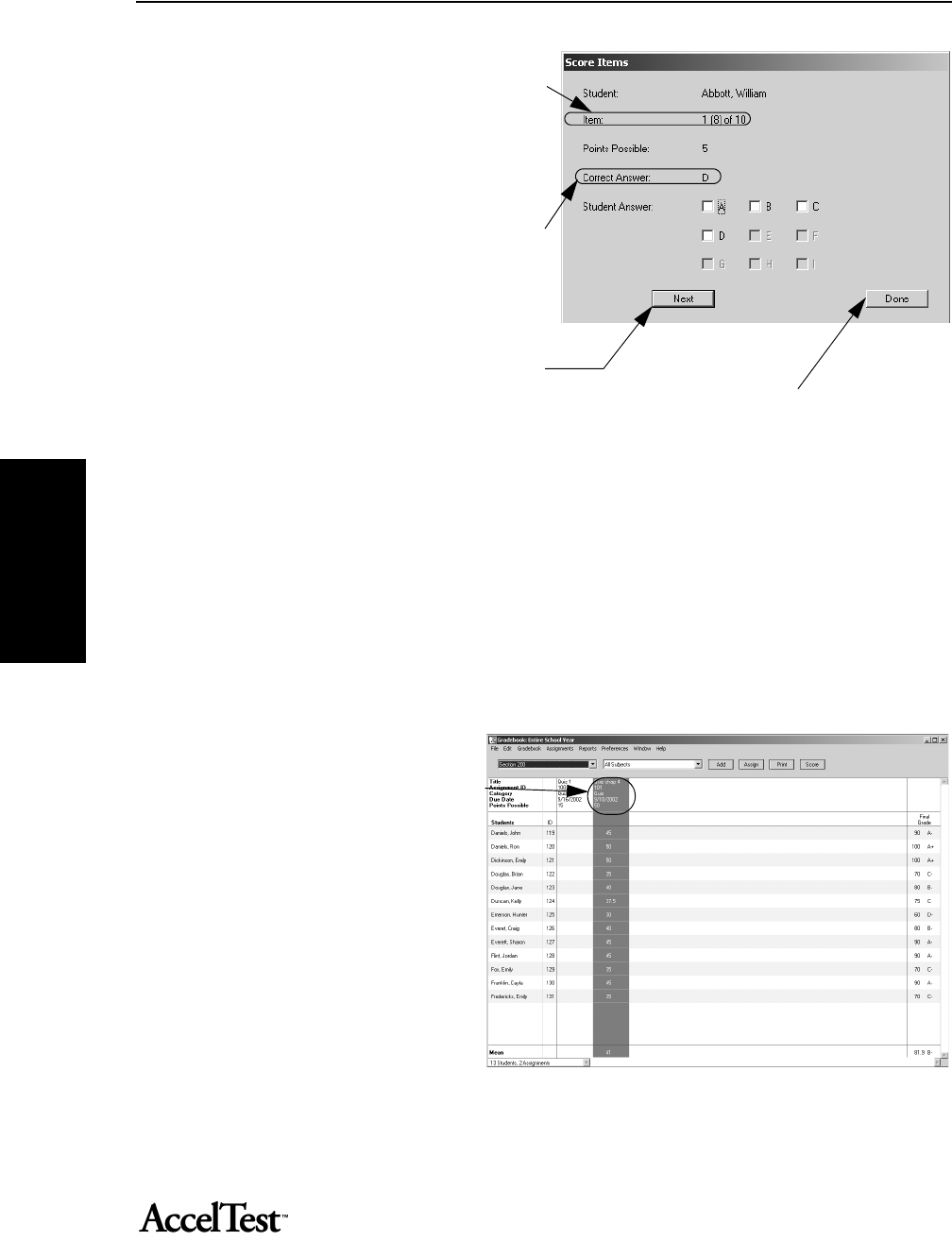
Assignment
28
Assignment
4. The Score Items dialog box will open. Look at
the Item entry, “1 (8) of 10.” In the example
shown, this describes the variation; your original
item (8) was shuffled and is currently item 1 for
William Abbot and other students who received
the A variation.
The correct answer for item 1, is “D” as shown at
Correct Answer.
Look at the answer marked by William for item 1
on this assignment, and then click on the
corresponding letter next to Student Answer.
Click [Next].
Repeat, entering William’s answer for each item. When you reach the last item, Click [Done].
Correct and incorrect points for William’s answers will be entered in the row to the right of his name. The
Score (%) column will show William’s total assignment score.
5. Repeat step 3 and 4 for each student.
6. After you have entered the items for each student, you are finished. To return to the Gradebook screen, click
on the File menu and click Close.
Editing Scores at the Keyboard
1. From the Gradebook screen, find the
assignment where you want to edit
item score(s). Double click in the
column heading for the assignment.
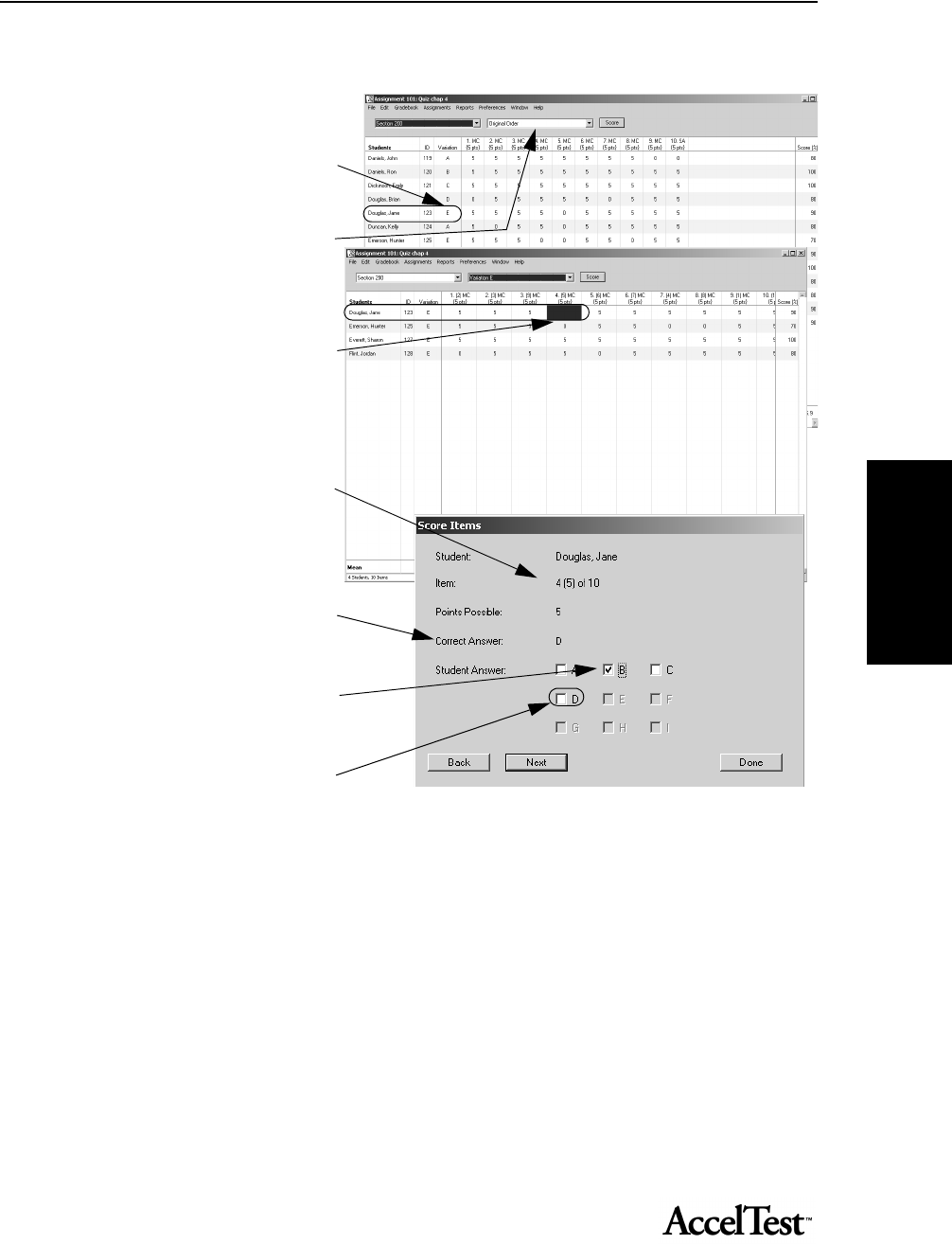
Assignment
29
Assignment
2. An expanded screen will open for the
selected assignment.
3. Find the student whose score you want
to edit. Find the variation under the
Variations column for that student.
4. Click on the student’s variation in the
Variation drop-down menu.
5. The window that opens lists the
students with the selected variation.
Find your student and then double-click
on the item you want to edit.
6. The Score Items dialog box will open.
Look at the Item entry, “4 (5) of 10.” In
the example shown, this describes the
variation; your original item (5) was
shuffled and is currently item 4 for
Jane Douglas and other students who
received the E variation.
The correct answer for item 4, is “D”
as shown at Correct Answer. If you are
correcting an item incorrectly scored,
you need to deselect the incorrect
answer at B by clicking on the checked
box next to it.
Then enter the correct answer by
clicking the check box next to D to
select it.
If you have other items that need correcting for Jane, Click [Next]. If not click [Done].
Edited item points for Jane’s answers will be entered in the row to the right of her name. The Score (%)
column will show Jane’s total assignment score.
7. Repeat steps 4, 5, and 6 for each student with items to edit for this variation.
8. Go back to step 3 and select the next variation and repeat steps 4, 5, and 6 for that variation for each student.
9. After you have edited the items for each student in each variation, you are finished. To return to the
Gradebook screen, click on the File menu and click Close.
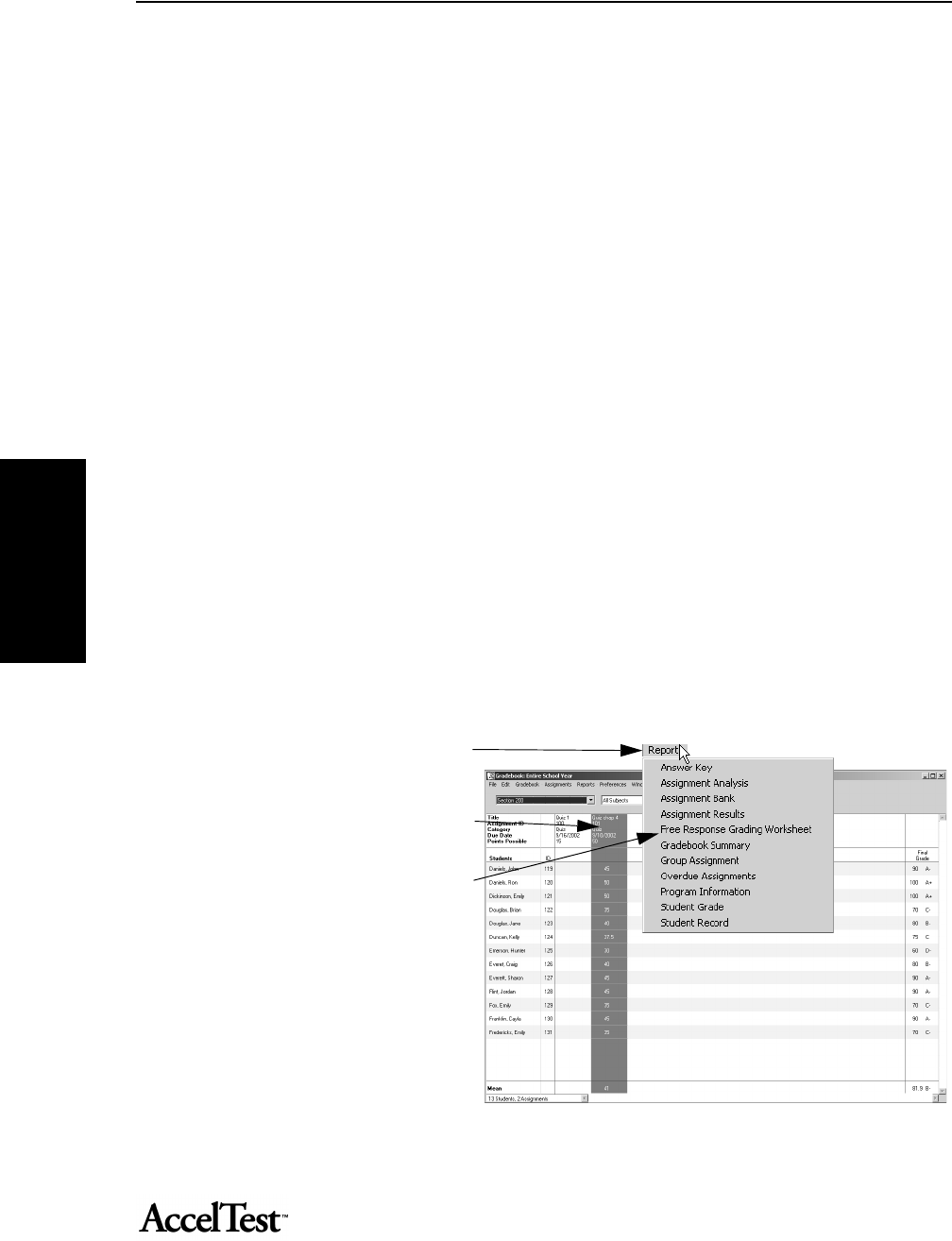
Assignment
30
Assignment
Teacher Instructions for Scoring Student Assignments
Scoring Free Response Items
For assignments with only assisted response items, students can score their own assignments using
AccelScan. AccelTest will record the grades in the Gradebook. See “Student Instructions for Using
AccelScan” on page 19. The teacher can use also AccelScan to score student scan cards.
If assignments contain one or more free response items, only the assisted response items are scored
and recorded. The Gradebook assumes that all students earn all of the points on free response items.
Free response items have to be graded by the teacher. To assist the teacher, AccelTest includes a
report called the Free Response Grading Worksheet. The worksheet provides a place for teachers to
record reduced point scores for free response items. The teacher must then update the Gradebook.
The Free Response Grading Worksheet should be printed after the students scan cards have been
scored. This shows the points earned for the assisted response items that were scanned, and aids the
teacher in grading the free response items.
Follow these instructions to score and record assignments with assisted response items and free
response items.
1. When your students complete their assignment, have them score their assignments. See “Student Instructions
for Using AccelScan” on page 19.
2. After all students have completed and scored the assignment, go to the Gradebook. Click in the top of the
assignment column. Print a Free Response Grading Worksheet report for the assignment.
To print the Free Response Grading Worksheet Report:
• Click on the Reports drop down
menu,
• Click in the top of column for the
assignment, and
• Click on Free Response Grading
Worksheet.
• Click [Preview] or [Print] if asked.
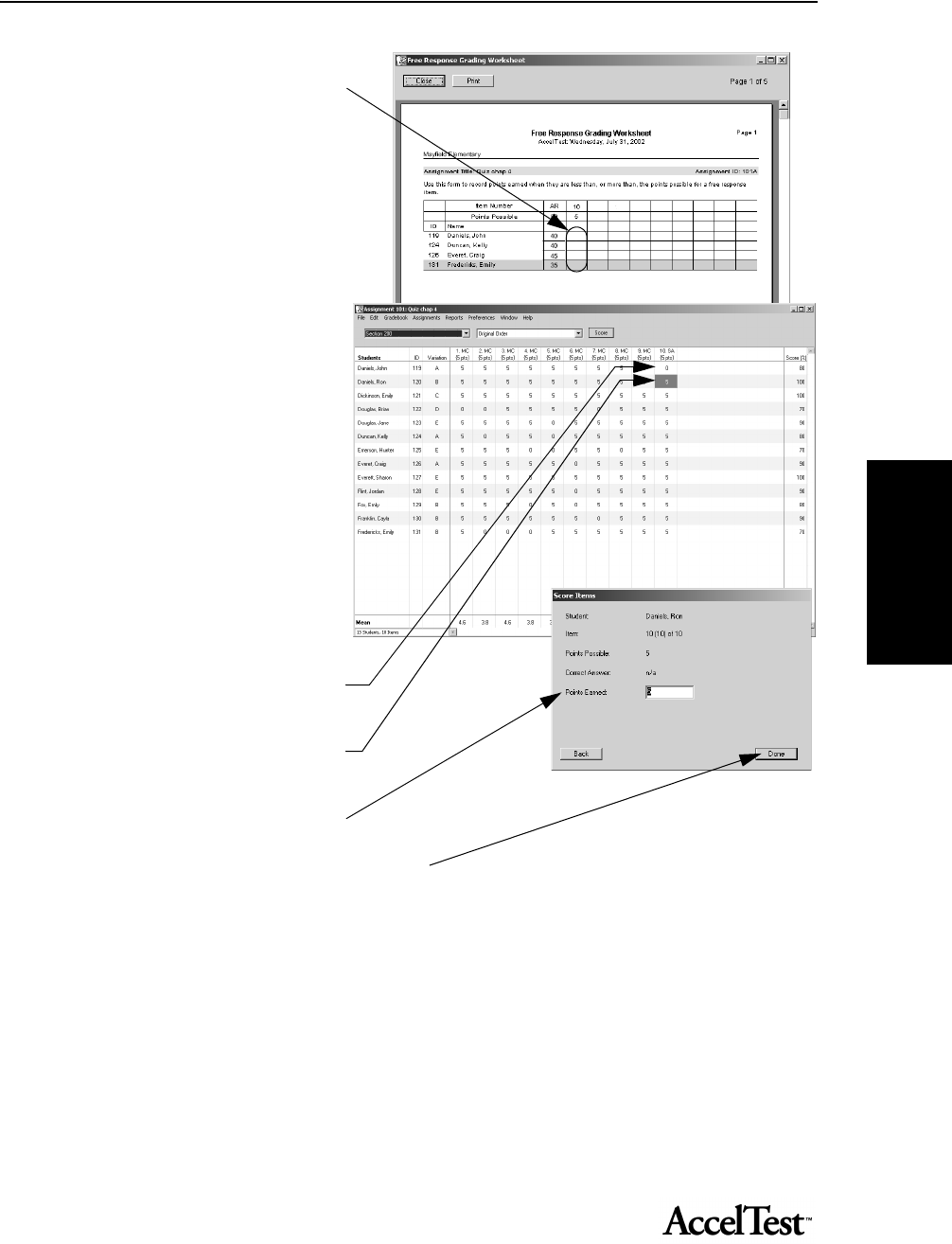
Assignment
31
Assignment
3. Record your scores for the students in
the Free Response Grading Worksheet.
If your assignment has variations, you
will have a separate worksheet for each
variation.
4. Return to your assignment in the
Gradebook. For assignments that have
been assigned, completed and scored,
the points scored per item for each
student appears in the columns.
Note: Free response items will show
the full point value until you evaluate
each student’s free response items and
decrease the items point value as
needed.
To adjust the free response point value,
double click in a free response item
column (item/column 10 here). Then
enter the point value you determined for
each students free response item. In this
case the item was a short answer (S.A.)
item.
In the first row, John missed item 10, so
item 10 has been scored at 0.
Next, to adjust Ron’s score, double-click
in the item 10 row for Ron.
Enter the corrected point value in the
Points Earned box.
Click [Done] and go on to the next free response student item you need to adjust.
5. When you have completed entering Free Response Item data, click on the File menu and click Close.
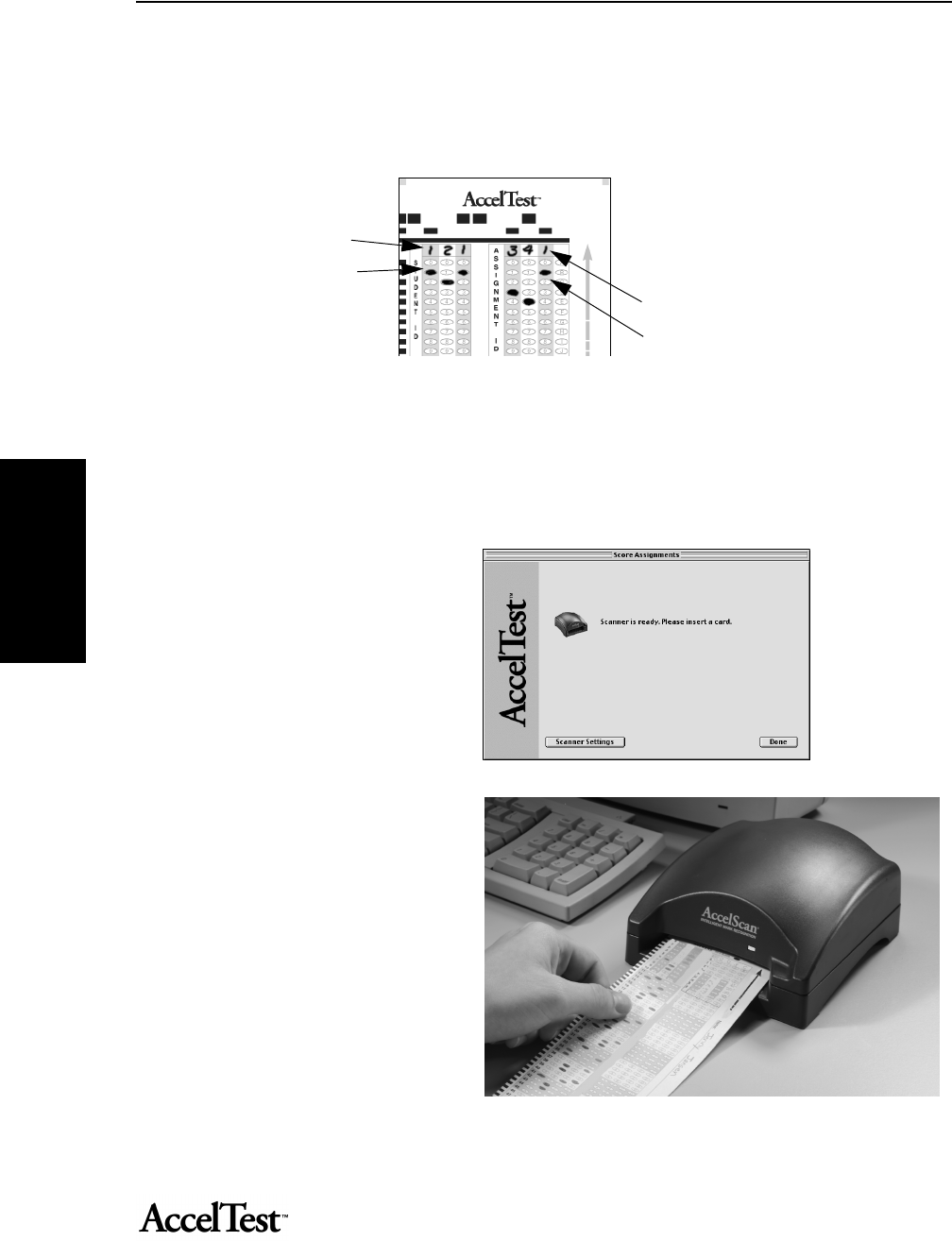
Assignment
32
Assignment
Using AccelScan from the Gradebook
1. Be sure that students filled in their three-digit Student ID number and Assignment ID number (and letter, if
used) at the top of the scan card. Fill in a bubble underneath each number (or letter).
2. Check over the students AccelScan scan card.
*Make sure that all answers have been filled in and marked next to the correct problem numbers.
*Erase any stray marks.
*If any answers were changed, be sure the old answers are completely erased.
3. From the Gradebook, click the [Score] button.
4. The Score Assignments screen shows
that the scanner is ready.
5. Insert the scan card into the scanner
face up, with the scan card number
and arrow going into the scanner first.
6. The scanner will take the scan card
and score the assignment. The
message saying the scanner is ready
will appear again. If AccelScan cannot
read your scan card a message will
tell you to see your teacher.
7. The card will be behind the scanner.
Save it so you can use the other side.
Fill in the Assignment ID numbers
(and letter, if used).
Fill in the bubbles under each digit
(or letter, if used).
Fill in the Student ID numbers.
Fill in the bubbles under each digit.
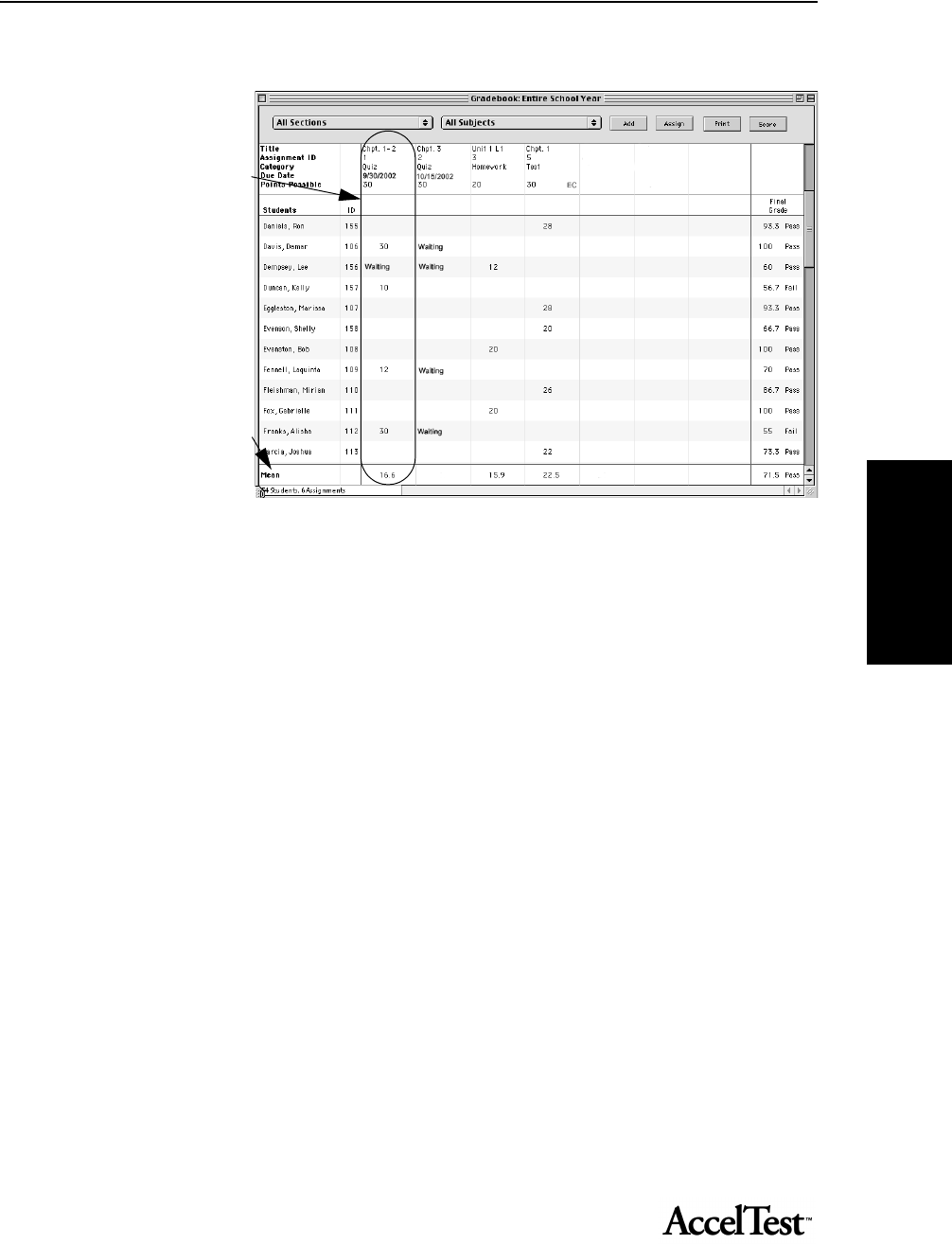
Assignment
33
Assignment
8. Repeat steps 1 through 7 for each student scan card.
9. When you have finished,
all the student scores will
be recorded in the
assignment’s column in
the Gradebook.
10. Students who have not
yet completed the
assignment will show
“Waiting” in the row with
their name. When their
cards are scanned, the
score replaces “Waiting.”
Click on Mean to switch to
Median scores in the last
row. Click Median to go
back to Mean.
Important: If the Due Date elapses before the student completes the assignment, the status will show as
overdue in the Gradebook, and it will be scored as a 0.
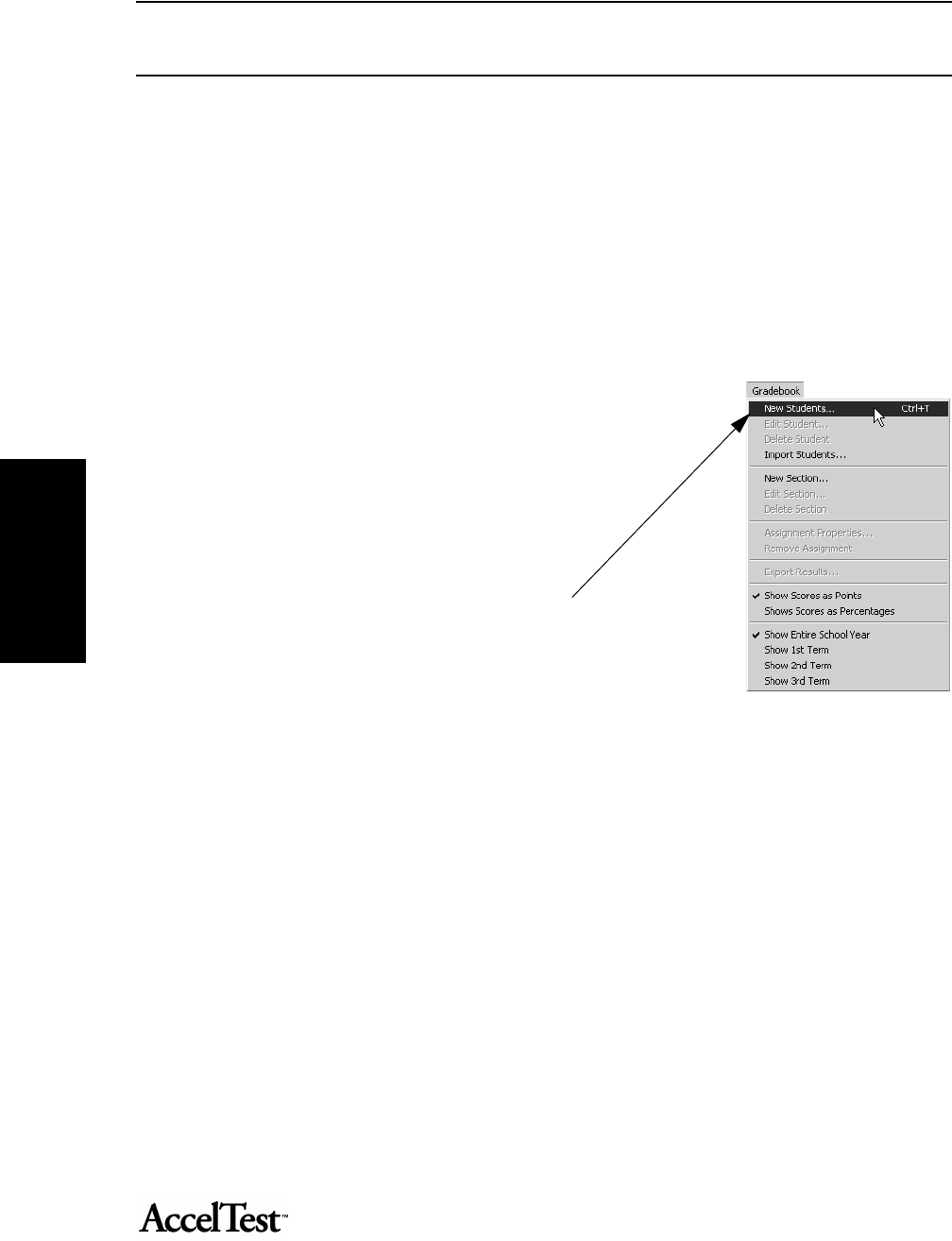
Assignment
34
Assignment
Gradebook Drop-down Menu
From AccelTest’s Getting Started window, click the [Gradebook] button. The Gradebook drop-
down menu provides access to many key Gradebook functions.
When you start using AccelTest for the first time, you will need to do this in Gradebook:
• First, you must create your class sections. See“New Section” on page 39.
• Next, enter your students. See the New Students section below.
New Students
Note: To save time, you should create your class
sections before you add or import students. See“New
Section” on page 39.
If you are adding students who are already in a
database that you can import into AccelTest, see
“Importing Student Data into AccelTest” on page 36.
1. If you need to add new students who are not in a
database at your school, go to the Gradebook menu
and click New Students.
2. In the New Students dialog box, under the Names
tab, type in each student’s name in the “First Name”
and “Last Name” boxes. Click [Add] and repeat for each student you are adding.
Note: If you will be adding the student(s) to a class section, add all the students for the class section at one
time, then go to step 3 to select the class section. If you are not adding the students to a class section, go to
step 4.
3. If you want to add the students to a class section at this time, click the Sections tab.
Under “Sections to choose from,” click on the class section you want. Click [Add].
Click OK.
4. Repeat steps 1 - 3 to add more students. When you have finished adding students click [OK].
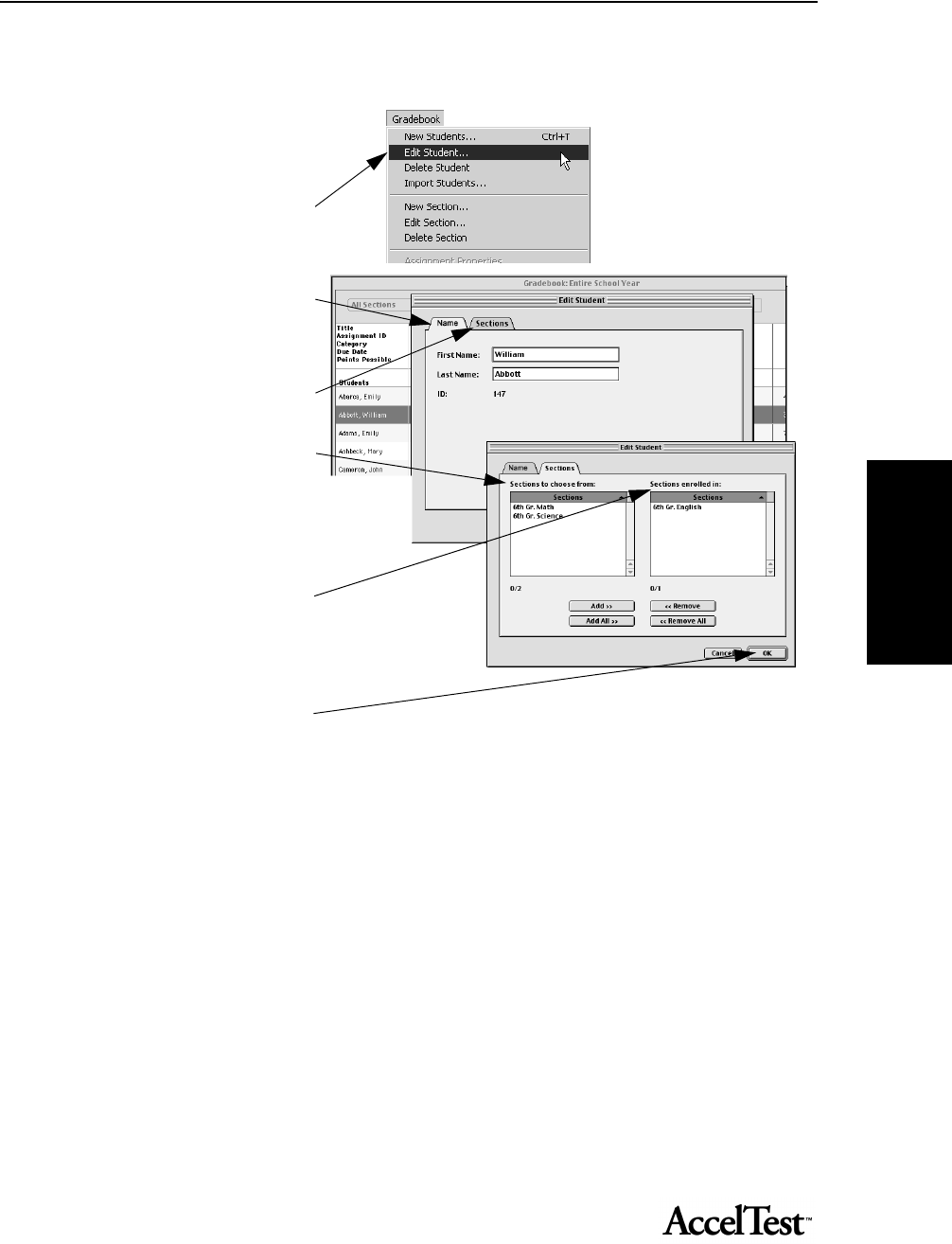
Assignment
35
Assignment
Edit Student
1. To edit information for a student,
from the Gradebook screen,
first click on the students name.
Then click on Edit Student in the
Gradebook drop-down menu.
2. You can edit the student’s name, in
the Edit Student dialog box Name
tab.
To add the student to a section or
delete from a section, simply click
on the Sections tab.
In the Sections tab dialog box,
under Sections to choose from, click
on the section you want to add the
student to.
To delete the student from a
section, under Sections enrolled in,
click on the section you want to
remove the student from. Click the
[Remove] button.
When you have finished, click [OK].
Delete Student
Note: Deleting a student will result in the loss of all the information for that student, including
class enrollment, grades, etc.
1. To delete information for a student, click on the students name and then click on Delete Student in the
Gradebook drop-down menu.
2. When you are asked if you want to delete this student, click [Yes].